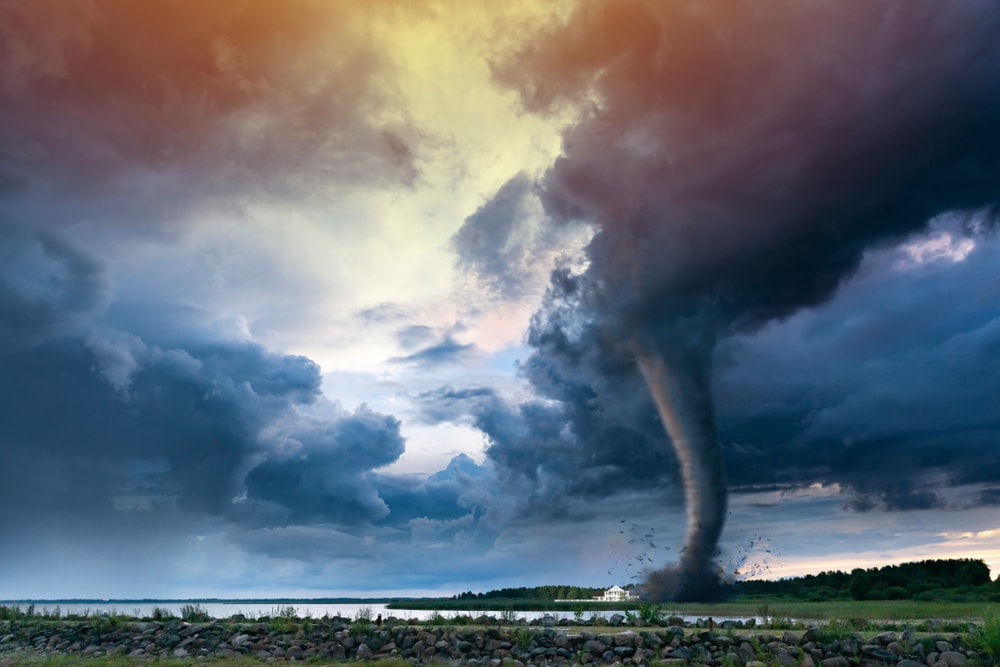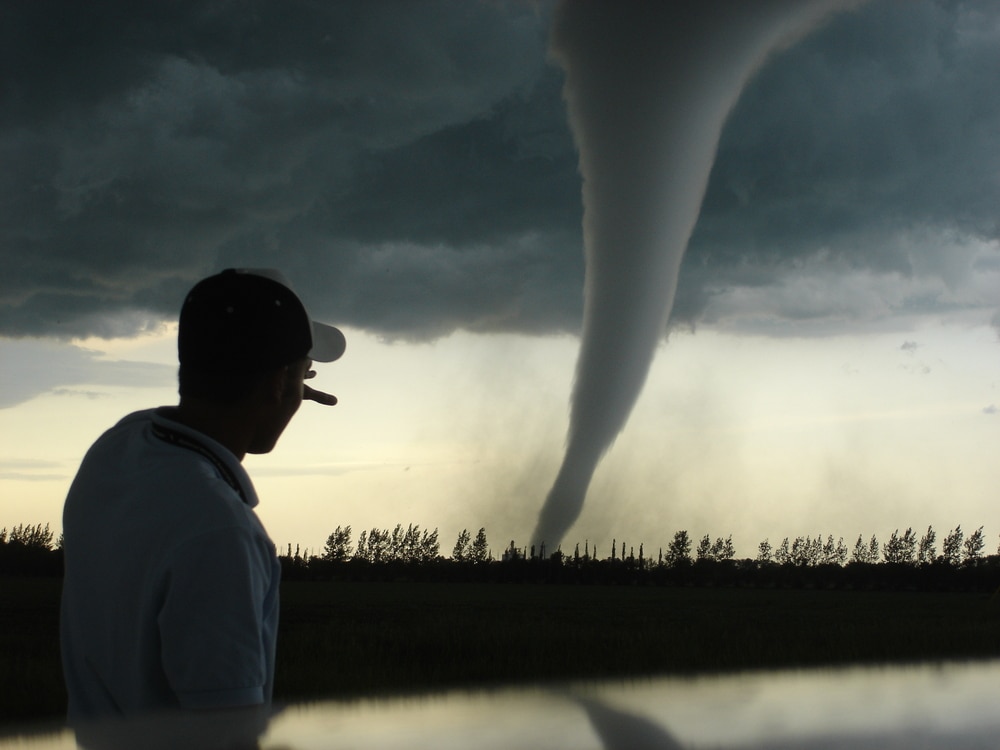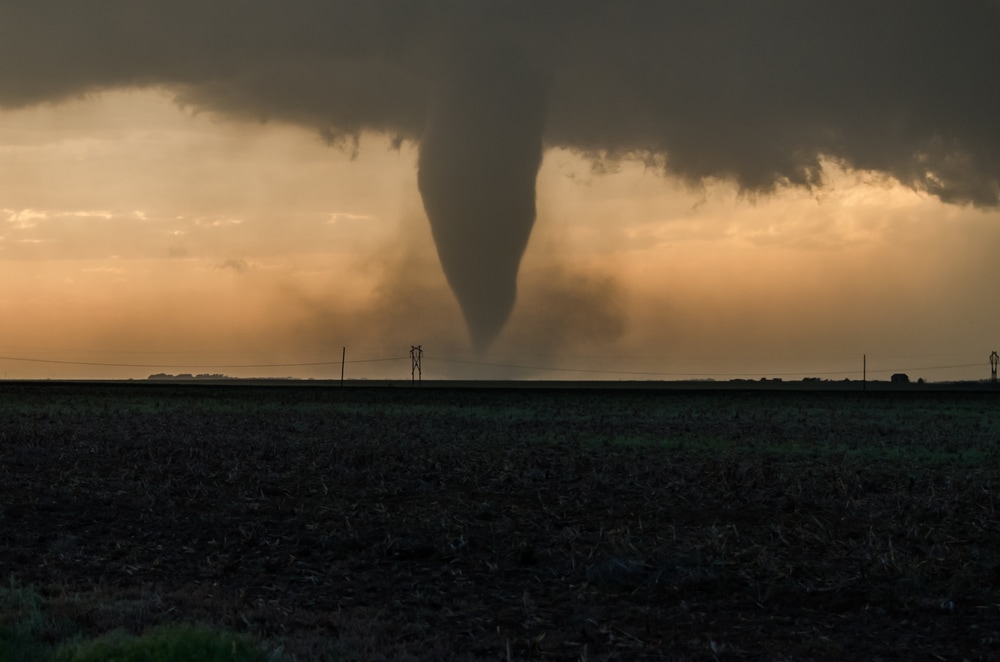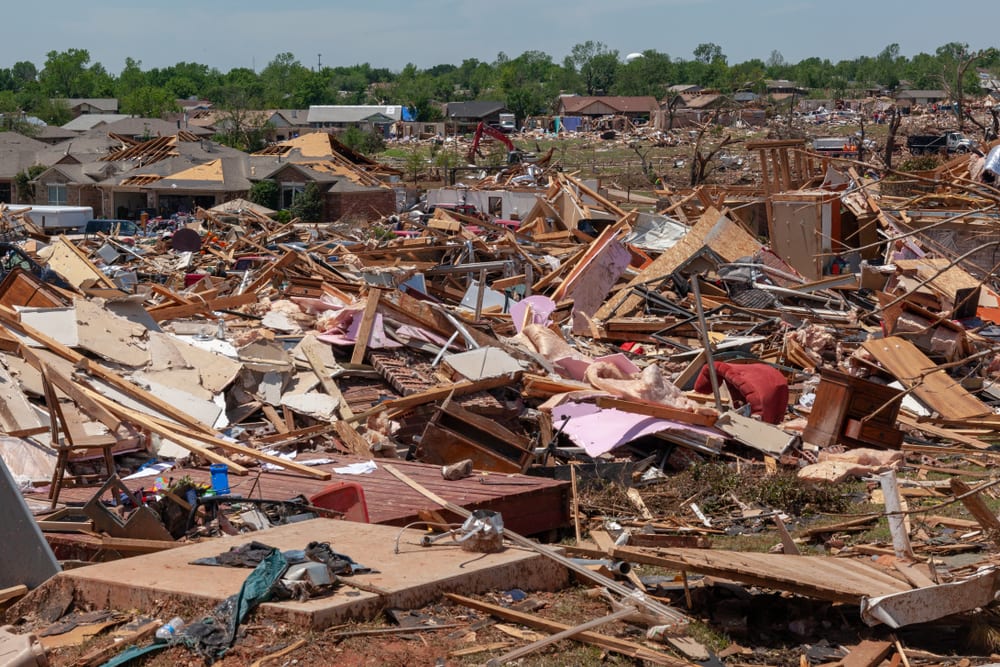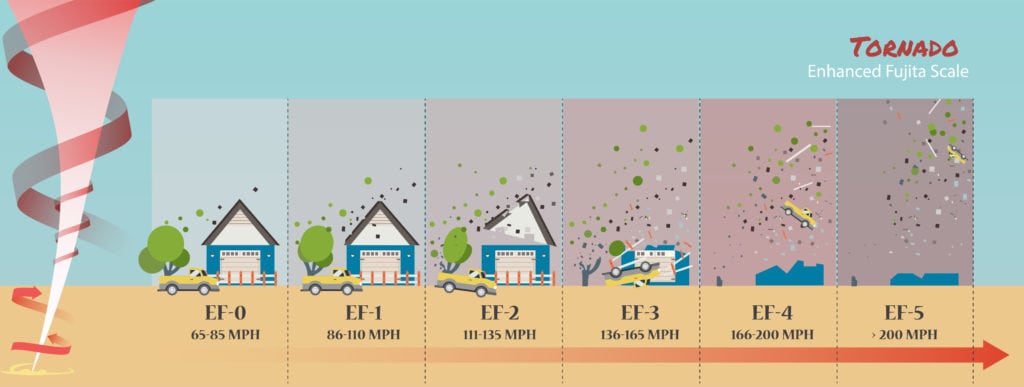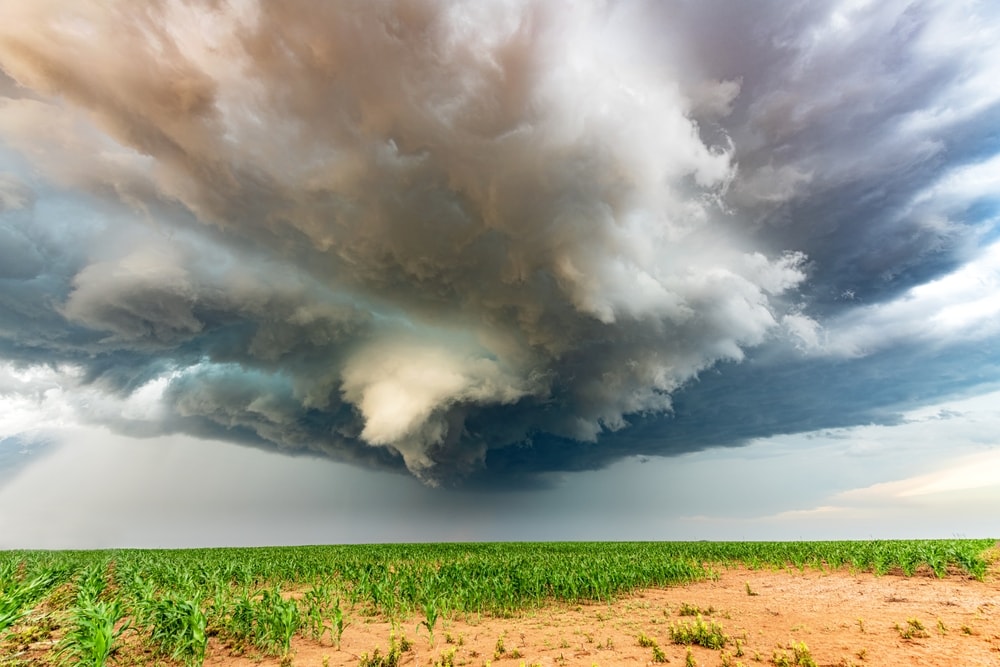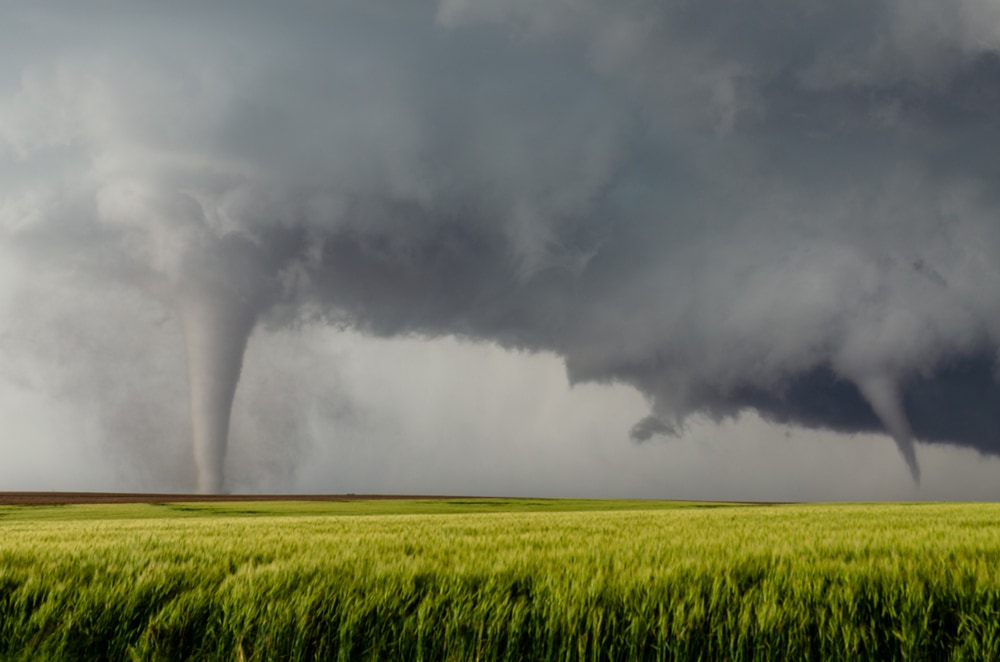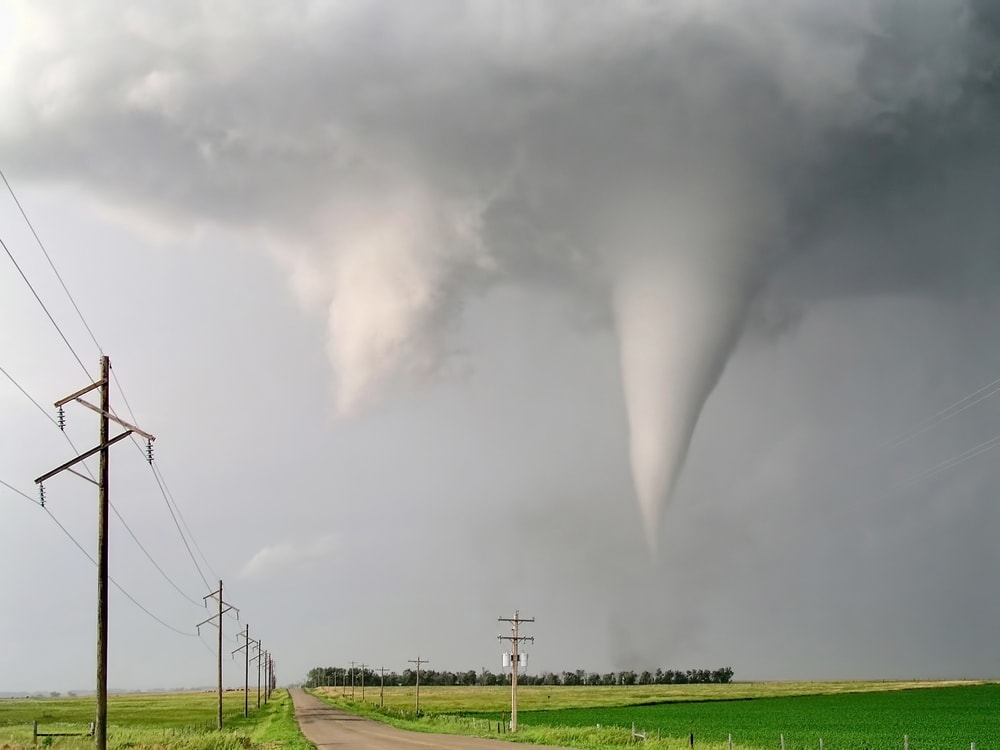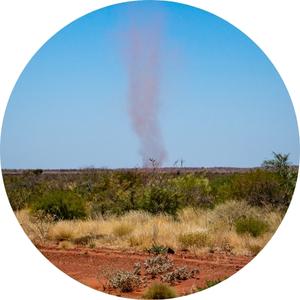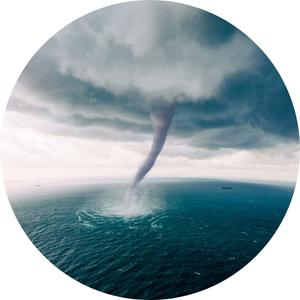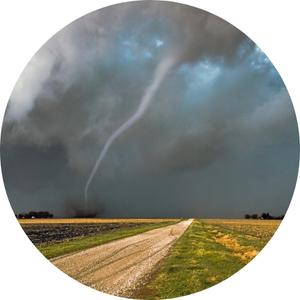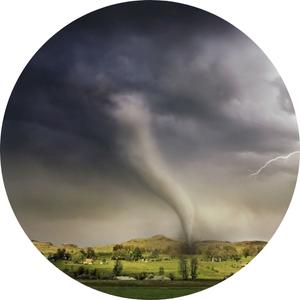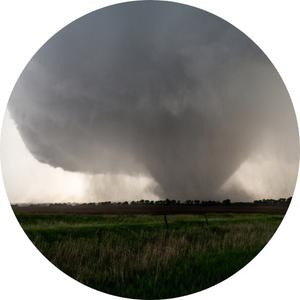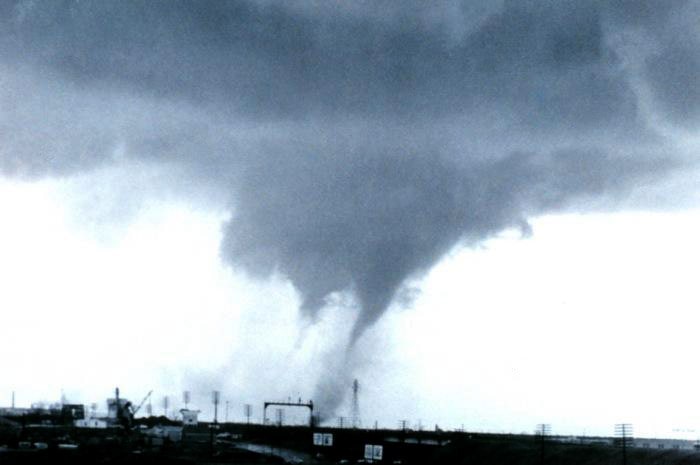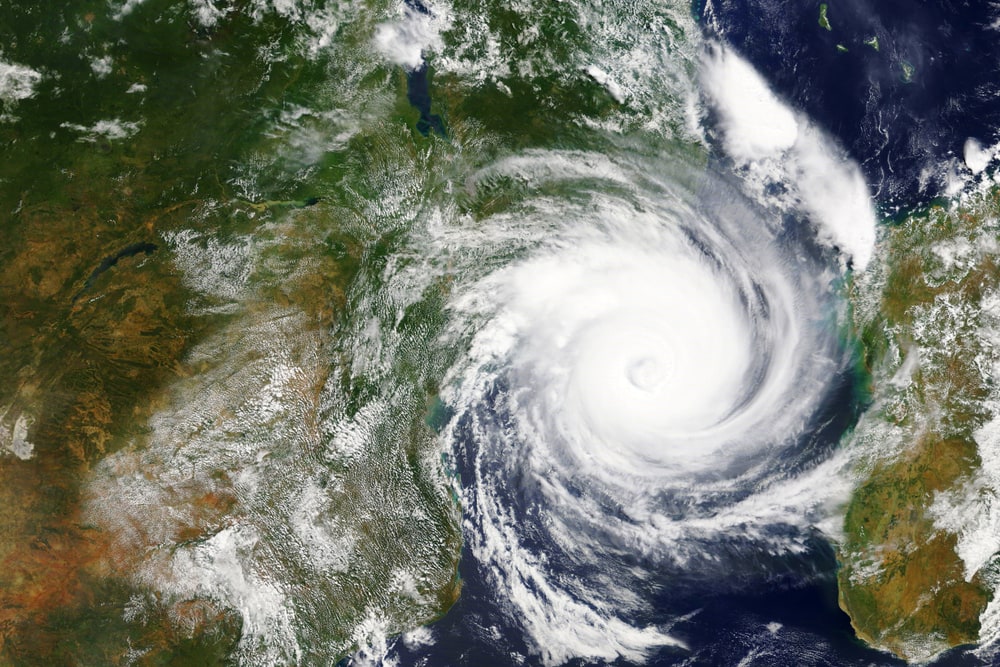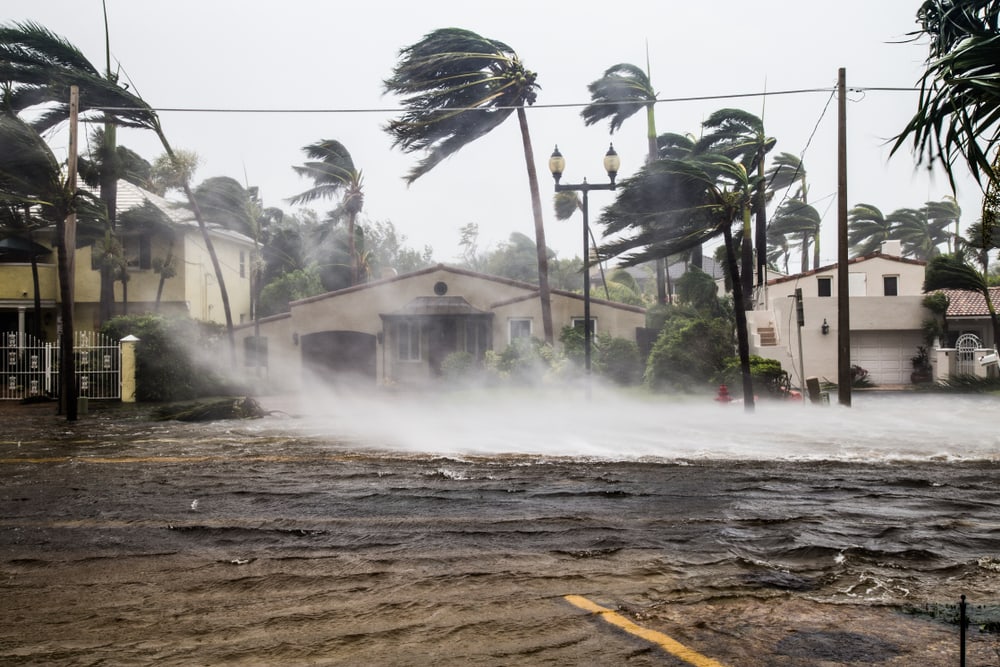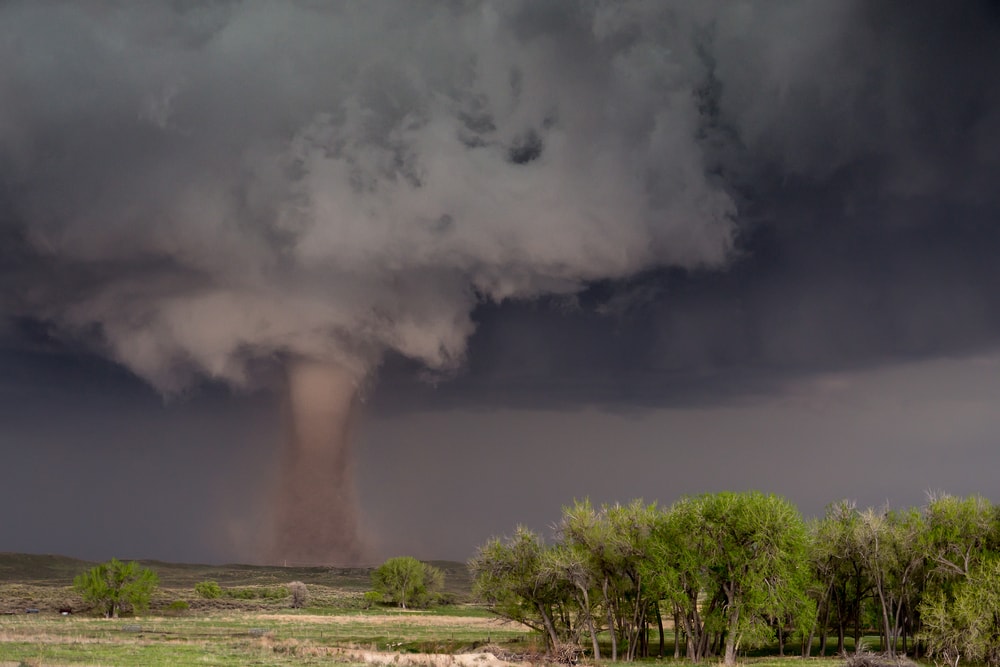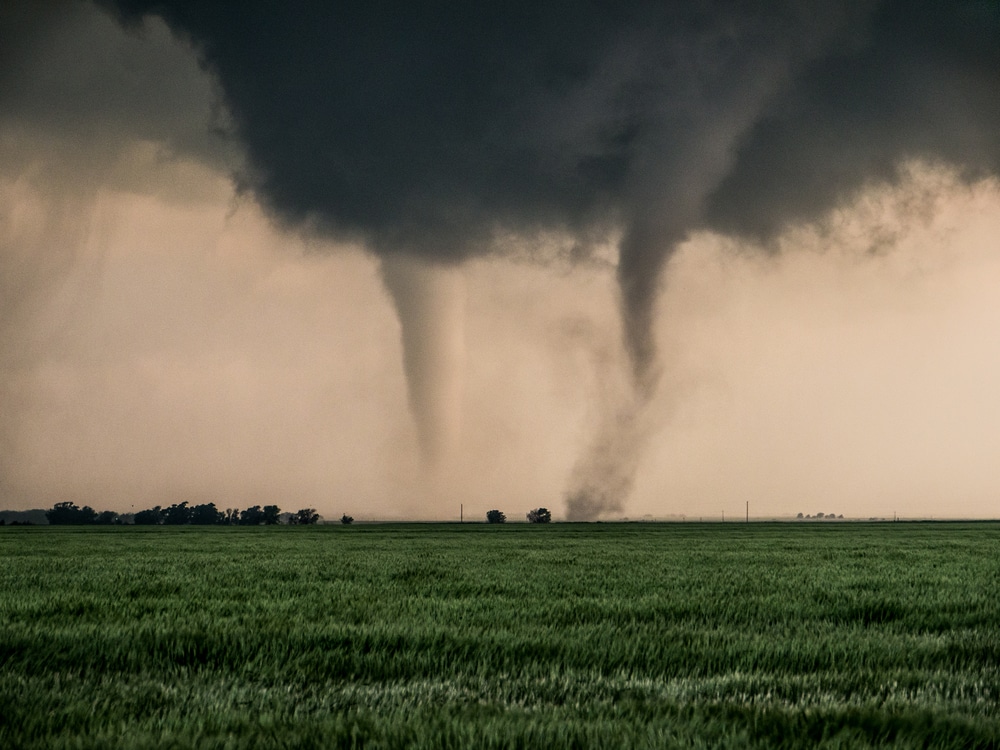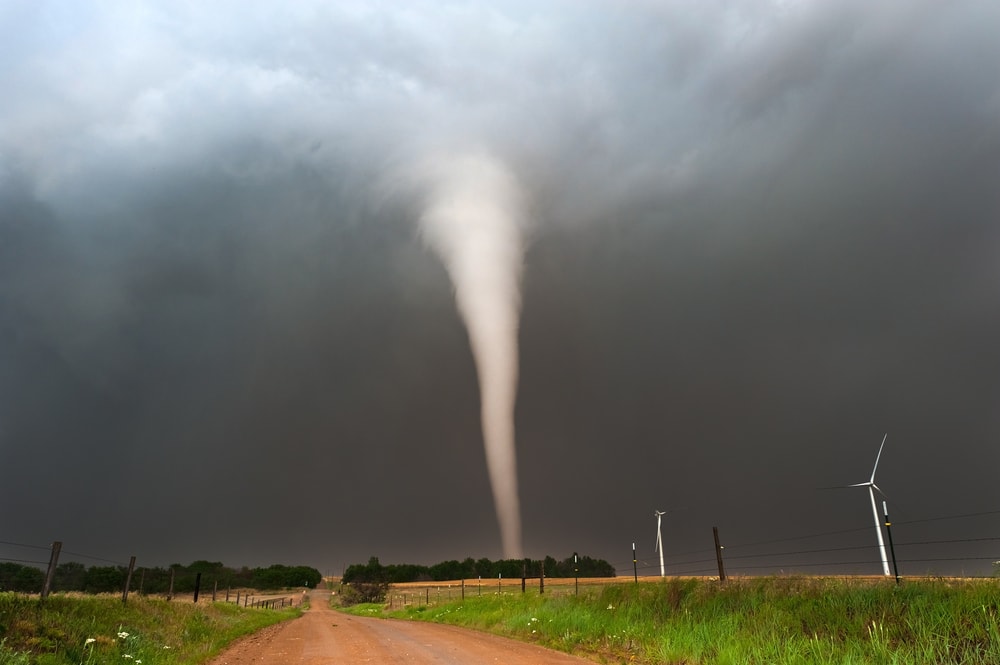A tornado is a violently rotating column of air that is in contact with both the surface of the Earth and a cumulonimbus cloud or, in rare cases, the base of a cumulus cloud. It is often referred to as a twister, whirlwind or cyclone,[1] although the word cyclone is used in meteorology to name a weather system with a low-pressure area in the center around which, from an observer looking down toward the surface of the Earth, winds blow counterclockwise in the Northern Hemisphere and clockwise in the Southern.[2] Tornadoes come in many shapes and sizes, and they are often visible in the form of a condensation funnel originating from the base of a cumulonimbus cloud, with a cloud of rotating debris and dust beneath it. Most tornadoes have wind speeds less than 180 kilometers per hour (110 miles per hour), are about 80 meters (250 feet) across, and travel several kilometers (a few miles) before dissipating. The most extreme tornadoes can attain wind speeds of more than 480 kilometers per hour (300 mph), are more than 3 kilometers (2 mi) in diameter, and stay on the ground for more than 100 km (60 mi).[3][4][5]
| Tornado | |
|---|---|
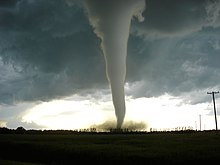
A tornado approaching Elie, Manitoba, Canada. |
|
| Season | Primarily spring and summer, but can occur at any time of year with the right atmospheric conditions |
| Effect | Wind damage |
Various types of tornadoes include the multiple vortex tornado, landspout, and waterspout. Waterspouts are characterized by a spiraling funnel-shaped wind current, connecting to a large cumulus or cumulonimbus cloud. They are generally classified as non-supercellular tornadoes that develop over bodies of water, but there is disagreement over whether to classify them as true tornadoes. These spiraling columns of air frequently develop in tropical areas close to the equator and are less common at high latitudes.[6] Other tornado-like phenomena that exist in nature include the gustnado, dust devil, fire whirl, and steam devil.
Tornadoes occur most frequently in North America (particularly in central and southeastern regions of the United States colloquially known as Tornado Alley; the United States and Canada have by far the most tornadoes of any countries in the world).[7] Tornadoes also occur in South Africa, much of Europe (except Spain, most of the Alps, Balkans, and northern Scandinavia), western and eastern Australia, New Zealand, Bangladesh and adjacent eastern India, Japan, the Philippines, and southeastern South America (Uruguay and Argentina).[8][9] Tornadoes can be detected before or as they occur through the use of pulse-Doppler radar by recognizing patterns in velocity and reflectivity data, such as hook echoes or debris balls, as well as through the efforts of storm spotters.[citation needed]
Tornado rating scales
There are several scales for rating the strength of tornadoes. The Fujita scale rates tornadoes by damage caused and has been replaced in some countries by the updated Enhanced Fujita Scale. An F0 or EF0 tornado, the weakest category, damages trees, but not substantial structures. An F5 or EF5 tornado, the strongest category, rips buildings off their foundations and can deform large skyscrapers. The similar TORRO scale ranges from T0 for extremely weak tornadoes to T11 for the most powerful known tornadoes.[10] Doppler radar data, photogrammetry, and ground swirl patterns (trochoidal marks) may also be analyzed to determine intensity and assign a rating.[11][12]
A tornado near Anadarko, Oklahoma, 1999. The funnel is the thin tube reaching from the cloud to the ground. The lower part of this tornado is surrounded by a translucent dust cloud, kicked up by the tornado’s strong winds at the surface. The wind of the tornado has a much wider radius than the funnel itself.
Etymology
The word tornado comes from the Spanish word tornado (past participle of ‘to turn’, or ‘to have turned’, which comes from the Latin tonare ‘to thunder’.[13][14] Tornadoes’ opposite phenomena are the widespread, straight-line derechos (, from Spanish: derecho [deˈɾetʃo], ‘straight’). A tornado is also commonly referred to as a «twister» or the old-fashioned colloquial term cyclone.[15][16]
Definitions
A tornado is a violently rotating column of air, in contact with the ground, either pendant from a cumuliform cloud or underneath a cumuliform cloud, and often (but not always) visible as a funnel cloud.[17] For a vortex to be classified as a tornado, it must be in contact with both the ground and the cloud base. The term is not precisely defined; for example, there is disagreement as to whether separate touchdowns of the same funnel constitute separate tornadoes.[5] Tornado refers to the vortex of wind, not the condensation cloud.[18][19]
Funnel cloud
This tornado has no funnel cloud; however, the rotating dust cloud indicates that strong winds are occurring at the surface, and thus it is a true tornado.
A tornado is not necessarily visible; however, the intense low pressure caused by the high wind speeds (as described by Bernoulli’s principle) and rapid rotation (due to cyclostrophic balance) usually cause water vapor in the air to condense into cloud droplets due to adiabatic cooling. This results in the formation of a visible funnel cloud or condensation funnel.[20]
There is some disagreement over the definition of a funnel cloud and a condensation funnel. According to the Glossary of Meteorology, a funnel cloud is any rotating cloud pendant from a cumulus or cumulonimbus, and thus most tornadoes are included under this definition.[21] Among many meteorologists, the ‘funnel cloud’ term is strictly defined as a rotating cloud which is not associated with strong winds at the surface, and condensation funnel is a broad term for any rotating cloud below a cumuliform cloud.[5]
Tornadoes often begin as funnel clouds with no associated strong winds at the surface, and not all funnel clouds evolve into tornadoes. Most tornadoes produce strong winds at the surface while the visible funnel is still above the ground, so it is difficult to discern the difference between a funnel cloud and a tornado from a distance.[5]
Outbreaks and families
Occasionally, a single storm will produce more than one tornado, either simultaneously or in succession. Multiple tornadoes produced by the same storm cell are referred to as a «tornado family».[22] Several tornadoes are sometimes spawned from the same large-scale storm system. If there is no break in activity, this is considered a tornado outbreak (although the term «tornado outbreak» has various definitions). A period of several successive days with tornado outbreaks in the same general area (spawned by multiple weather systems) is a tornado outbreak sequence, occasionally called an extended tornado outbreak.[17][23][24]
Characteristics
Size and shape
Most tornadoes take on the appearance of a narrow funnel, a few hundred meters (yards) across, with a small cloud of debris near the ground. Tornadoes may be obscured completely by rain or dust. These tornadoes are especially dangerous, as even experienced meteorologists might not see them.[25]
Small, relatively weak landspouts may be visible only as a small swirl of dust on the ground. Although the condensation funnel may not extend all the way to the ground, if associated surface winds are greater than 64 km/h (40 mph), the circulation is considered a tornado.[18] A tornado with a nearly cylindrical profile and relatively low height is sometimes referred to as a «stovepipe» tornado. Large tornadoes which appear at least as wide as their cloud-to-ground height can look like large wedges stuck into the ground, and so are known as «wedge tornadoes» or «wedges».[26] The «stovepipe» classification is also used for this type of tornado if it otherwise fits that profile. A wedge can be so wide that it appears to be a block of dark clouds, wider than the distance from the cloud base to the ground. Even experienced storm observers may not be able to tell the difference between a low-hanging cloud and a wedge tornado from a distance. Many, but not all major tornadoes are wedges.[26]
Tornadoes in the dissipating stage can resemble narrow tubes or ropes, and often curl or twist into complex shapes. These tornadoes are said to be «roping out», or becoming a «rope tornado». When they rope out, the length of their funnel increases, which forces the winds within the funnel to weaken due to conservation of angular momentum.[27] Multiple-vortex tornadoes can appear as a family of swirls circling a common center, or they may be completely obscured by condensation, dust, and debris, appearing to be a single funnel.[28]
In the United States, tornadoes are around 500 feet (150 m) across on average.[25] However, there is a wide range of tornado sizes. Weak tornadoes, or strong yet dissipating tornadoes, can be exceedingly narrow, sometimes only a few feet or couple meters across. One tornado was reported to have a damage path only 7 feet (2.1 m) long.[25] On the other end of the spectrum, wedge tornadoes can have a damage path a mile (1.6 km) wide or more. A tornado that affected Hallam, Nebraska on May 22, 2004, was up to 2.5 miles (4.0 km) wide at the ground, and a tornado in El Reno, Oklahoma on May 31, 2013, was approximately 2.6 miles (4.2 km) wide, the widest on record.[4][29]
Track length
In the United States, the average tornado travels on the ground for 5 miles (8.0 km). However, tornadoes are capable of both much shorter and much longer damage paths: one tornado was reported to have a damage path only 7 feet (2.1 m) long, while the record-holding tornado for path length—the Tri-State Tornado, which affected parts of Missouri, Illinois, and Indiana on March 18, 1925—was on the ground continuously for 219 miles (352 km).[25] Many tornadoes which appear to have path lengths of 100 miles (160 km) or longer are composed of a family of tornadoes which have formed in quick succession; however, there is no substantial evidence that this occurred in the case of the Tri-State Tornado.[23] In fact, modern reanalysis of the path suggests that the tornado may have begun 15 miles (24 km) further west than previously thought.[30]
Appearance
Photographs of the Waurika, Oklahoma tornado of May 30, 1976, taken at nearly the same time by two photographers. In the top picture, the tornado is lit by the sunlight focused from behind the camera, thus the funnel appears bluish. In the lower image, where the camera is facing the opposite direction, the sun is behind the tornado, giving it a dark appearance.[31]
Tornadoes can have a wide range of colors, depending on the environment in which they form. Those that form in dry environments can be nearly invisible, marked only by swirling debris at the base of the funnel. Condensation funnels that pick up little or no debris can be gray to white. While traveling over a body of water (as a waterspout), tornadoes can turn white or even blue. Slow-moving funnels, which ingest a considerable amount of debris and dirt, are usually darker, taking on the color of debris. Tornadoes in the Great Plains can turn red because of the reddish tint of the soil, and tornadoes in mountainous areas can travel over snow-covered ground, turning white.[25]
Lighting conditions are a major factor in the appearance of a tornado. A tornado which is «back-lit» (viewed with the sun behind it) appears very dark. The same tornado, viewed with the sun at the observer’s back, may appear gray or brilliant white. Tornadoes which occur near the time of sunset can be many different colors, appearing in hues of yellow, orange, and pink.[15][32]
Dust kicked up by the winds of the parent thunderstorm, heavy rain and hail, and the darkness of night are all factors that can reduce the visibility of tornadoes. Tornadoes occurring in these conditions are especially dangerous, since only weather radar observations, or possibly the sound of an approaching tornado, serve as any warning to those in the storm’s path. Most significant tornadoes form under the storm’s updraft base, which is rain-free,[33] making them visible.[34] Also, most tornadoes occur in the late afternoon, when the bright sun can penetrate even the thickest clouds.[23]
There is mounting evidence, including Doppler on Wheels mobile radar images and eyewitness accounts, that most tornadoes have a clear, calm center with extremely low pressure, akin to the eye of tropical cyclones. Lightning is said to be the source of illumination for those who claim to have seen the interior of a tornado.[35][36][37]
Rotation
Tornadoes normally rotate cyclonically (when viewed from above, this is counterclockwise in the northern hemisphere and clockwise in the southern). While large-scale storms always rotate cyclonically due to the Coriolis effect, thunderstorms and tornadoes are so small that the direct influence of the Coriolis effect is unimportant, as indicated by their large Rossby numbers. Supercells and tornadoes rotate cyclonically in numerical simulations even when the Coriolis effect is neglected.[38][39] Low-level mesocyclones and tornadoes owe their rotation to complex processes within the supercell and ambient environment.[40]
Approximately 1 percent of tornadoes rotate in an anticyclonic direction in the northern hemisphere. Typically, systems as weak as landspouts and gustnadoes can rotate anticyclonically, and usually only those which form on the anticyclonic shear side of the descending rear flank downdraft (RFD) in a cyclonic supercell.[41] On rare occasions, anticyclonic tornadoes form in association with the mesoanticyclone of an anticyclonic supercell, in the same manner as the typical cyclonic tornado, or as a companion tornado either as a satellite tornado or associated with anticyclonic eddies within a supercell.[42]
Sound and seismology
Tornadoes emit widely on the acoustics spectrum and the sounds are caused by multiple mechanisms. Various sounds of tornadoes have been reported, mostly related to familiar sounds for the witness and generally some variation of a whooshing roar. Popularly reported sounds include a freight train, rushing rapids or waterfall, a nearby jet engine, or combinations of these. Many tornadoes are not audible from much distance; the nature of and the propagation distance of the audible sound depends on atmospheric conditions and topography.[5]
The winds of the tornado vortex and of constituent turbulent eddies, as well as airflow interaction with the surface and debris, contribute to the sounds. Funnel clouds also produce sounds. Funnel clouds and small tornadoes are reported as whistling, whining, humming, or the buzzing of innumerable bees or electricity, or more or less harmonic, whereas many tornadoes are reported as a continuous, deep rumbling, or an irregular sound of «noise».[43]
Since many tornadoes are audible only when very near, sound is not to be thought of as a reliable warning signal for a tornado. Tornadoes are also not the only source of such sounds in severe thunderstorms; any strong, damaging wind, a severe hail volley, or continuous thunder in a thunderstorm may produce a roaring sound.[44]
Tornadoes also produce identifiable inaudible infrasonic signatures.[45]
Unlike audible signatures, tornadic signatures have been isolated; due to the long-distance propagation of low-frequency sound, efforts are ongoing to develop tornado prediction and detection devices with additional value in understanding tornado morphology, dynamics, and creation.[46] Tornadoes also produce a detectable seismic signature, and research continues on isolating it and understanding the process.[47]
Electromagnetic, lightning, and other effects
Tornadoes emit on the electromagnetic spectrum, with sferics and E-field effects detected.[46][48][49] There are observed correlations between tornadoes and patterns of lightning. Tornadic storms do not contain more lightning than other storms and some tornadic cells never produce lightning at all. More often than not, overall cloud-to-ground (CG) lightning activity decreases as a tornado touches the surface and returns to the baseline level when the tornado dissipates. In many cases, intense tornadoes and thunderstorms exhibit an increased and anomalous dominance of positive polarity CG discharges.[50] Electromagnetics and lightning have little or nothing to do directly with what drives tornadoes (tornadoes are basically a thermodynamic phenomenon), although there are likely connections with the storm and environment affecting both phenomena.[citation needed]
Luminosity has been reported in the past and is probably due to misidentification of external light sources such as lightning, city lights, and power flashes from broken lines, as internal sources are now uncommonly reported and are not known to ever have been recorded. In addition to winds, tornadoes also exhibit changes in atmospheric variables such as temperature, moisture, and atmospheric pressure. For example, on June 24, 2003, near Manchester, South Dakota, a probe measured a 100-millibar (100 hPa; 3.0 inHg) pressure decrease. The pressure dropped gradually as the vortex approached then dropped extremely rapidly to 850 mbar (850 hPa; 25 inHg) in the core of the violent tornado before rising rapidly as the vortex moved away, resulting in a V-shape pressure trace. Temperature tends to decrease and moisture content to increase in the immediate vicinity of a tornado.[51]
Life cycle
Composite of eight images shot in sequence as a tornado formed in Kansas in 2016
A sequence of images showing the birth of a tornado. First, the rotating cloud base lowers. This lowering becomes a funnel, which continues descending while winds build near the surface, kicking up dust and debris and causing damage. As the pressure continues to drop, the visible funnel extends to the ground. This tornado, near Dimmitt, Texas, was one of the best-observed violent tornadoes in history.
Supercell relationship
Tornadoes often develop from a class of thunderstorms known as supercells. Supercells contain mesocyclones, an area of organized rotation a few kilometers/miles up in the atmosphere, usually 1.6–9.7 km (1–6 miles) across. Most intense tornadoes (EF3 to EF5 on the Enhanced Fujita Scale) develop from supercells. In addition to tornadoes, very heavy rain, frequent lightning, strong wind gusts, and hail are common in such storms.[52][53]
Most tornadoes from supercells follow a recognizable life cycle which begins when increasing rainfall drags with it an area of quickly descending air known as the rear flank downdraft (RFD). This downdraft accelerates as it approaches the ground, and drags the supercell’s rotating mesocyclone towards the ground with it.[18]
Formation
As the mesocyclone lowers below the cloud base, it begins to take in cool, moist air from the downdraft region of the storm. The convergence of warm air in the updraft and cool air causes a rotating wall cloud to form. The RFD also focuses the mesocyclone’s base, causing it to draw air from a smaller and smaller area on the ground. As the updraft intensifies, it creates an area of low pressure at the surface. This pulls the focused mesocyclone down, in the form of a visible condensation funnel. As the funnel descends, the RFD also reaches the ground, fanning outward and creating a gust front that can cause severe damage a considerable distance from the tornado. Usually, the funnel cloud begins causing damage on the ground (becoming a tornado) within a few minutes of the RFD reaching the ground.[18][54] Many other aspects of tornado formation (such as why some storms form tornadoes while others do not, or what precise role downdrafts, temperature, and moisture play in tornado formation) are still poorly understood.[55]
Maturity
Initially, the tornado has a good source of warm, moist air flowing inward to power it, and it grows until it reaches the «mature stage». This can last from a few minutes to more than an hour, and during that time a tornado often causes the most damage, and in rare cases can be more than 1.6 km (1 mile) across. The low pressured atmosphere at the base of the tornado is essential to the endurance of the system.[56] Meanwhile, the RFD, now an area of cool surface winds, begins to wrap around the tornado, cutting off the inflow of warm air which previously fed the tornado.[18]
The flow inside the funnel of the tornado is downward, supplying water vapor from the cloud above. This is contrary to the upward flow inside hurricanes, supplying water vapor from the warm ocean below. Therefore, the energy of the tornado is supplied from the cloud above. The complicated mechanism is explained in
[57][58]
Dissipation
As the RFD completely wraps around and chokes off the tornado’s air supply, the vortex begins to weaken, becoming thin and rope-like. This is the «dissipating stage», often lasting no more than a few minutes, after which the tornado ends. During this stage, the shape of the tornado becomes highly influenced by the winds of the parent storm, and can be blown into fantastic patterns.[23][31][32] Even though the tornado is dissipating, it is still capable of causing damage. The storm is contracting into a rope-like tube and, due to conservation of angular momentum, winds can increase at this point.[27]
As the tornado enters the dissipating stage, its associated mesocyclone often weakens as well, as the rear flank downdraft cuts off the inflow powering it. Sometimes, in intense supercells, tornadoes can develop cyclically. As the first mesocyclone and associated tornado dissipate, the storm’s inflow may be concentrated into a new area closer to the center of the storm and possibly feed a new mesocyclone. If a new mesocyclone develops, the cycle may start again, producing one or more new tornadoes. Occasionally, the old (occluded) mesocyclone and the new mesocyclone produce a tornado at the same time.[citation needed]
Although this is a widely accepted theory for how most tornadoes form, live, and die, it does not explain the formation of smaller tornadoes, such as landspouts, long-lived tornadoes, or tornadoes with multiple vortices. These each have different mechanisms which influence their development—however, most tornadoes follow a pattern similar to this one.[59]
Types
Multiple vortex
A multiple-vortex tornado is a type of tornado in which two or more columns of spinning air rotate about their own axes and at the same time revolve around a common center. A multi-vortex structure can occur in almost any circulation, but is very often observed in intense tornadoes. These vortices often create small areas of heavier damage along the main tornado path.[5][18] This is a phenomenon that is distinct from a satellite tornado, which is a smaller tornado that forms very near a large, strong tornado contained within the same mesocyclone. The satellite tornado may appear to «orbit» the larger tornado (hence the name), giving the appearance of one, large multi-vortex tornado. However, a satellite tornado is a distinct circulation, and is much smaller than the main funnel.[5]
Waterspout
A waterspout is defined by the National Weather Service as a tornado over water. However, researchers typically distinguish «fair weather» waterspouts from tornadic (i.e. associated with a mesocyclone) waterspouts. Fair weather waterspouts are less severe but far more common, and are similar to dust devils and landspouts. They form at the bases of cumulus congestus clouds over tropical and subtropical waters. They have relatively weak winds, smooth laminar walls, and typically travel very slowly. They occur most commonly in the Florida Keys and in the northern Adriatic Sea.[60][61][62] In contrast, tornadic waterspouts are stronger tornadoes over water. They form over water similarly to mesocyclonic tornadoes, or are stronger tornadoes which cross over water. Since they form from severe thunderstorms and can be far more intense, faster, and longer-lived than fair weather waterspouts, they are more dangerous.[63] In official tornado statistics, waterspouts are generally not counted unless they affect land, though some European weather agencies count waterspouts and tornadoes together.[5][64]
Landspout
A landspout near North Platte, Nebraska on May 22, 2004. Note the characteristic smooth, tubular shape, similar to that of a waterspout.
A landspout, or dust-tube tornado, is a tornado not associated with a mesocyclone. The name stems from their characterization as a «fair weather waterspout on land». Waterspouts and landspouts share many defining characteristics, including relative weakness, short lifespan, and a small, smooth condensation funnel that often does not reach the surface. Landspouts also create a distinctively laminar cloud of dust when they make contact with the ground, due to their differing mechanics from true mesoform tornadoes. Though usually weaker than classic tornadoes, they can produce strong winds which could cause serious damage.[5][18]
Similar circulations
Gustnado
A gustnado, or gust front tornado, is a small, vertical swirl associated with a gust front or downburst. Because they are not connected with a cloud base, there is some debate as to whether or not gustnadoes are tornadoes. They are formed when fast-moving cold, dry outflow air from a thunderstorm is blown through a mass of stationary, warm, moist air near the outflow boundary, resulting in a «rolling» effect (often exemplified through a roll cloud). If low level wind shear is strong enough, the rotation can be turned vertically or diagonally and make contact with the ground. The result is a gustnado.[5][65] They usually cause small areas of heavier rotational wind damage among areas of straight-line wind damage.[citation needed]
Dust devil
A dust devil (also known as a whirlwind) resembles a tornado in that it is a vertical swirling column of air. However, they form under clear skies and are no stronger than the weakest tornadoes. They form when a strong convective updraft is formed near the ground on a hot day. If there is enough low-level wind shear, the column of hot, rising air can develop a small cyclonic motion that can be seen near the ground. They are not considered tornadoes because they form during fair weather and are not associated with any clouds. However, they can, on occasion, result in major damage.[25][66]
Fire whirls
Small-scale, tornado-like circulations can occur near any intense surface heat source. Those that occur near intense wildfires are called fire whirls. They are not considered tornadoes, except in the rare case where they connect to a pyrocumulus or other cumuliform cloud above. Fire whirls usually are not as strong as tornadoes associated with thunderstorms. They can, however, produce significant damage.[23]
Steam devils
A steam devil is a rotating updraft between 50-and-200-metre wide (160 and 660 ft) that involves steam or smoke. These formations do not involve high wind speeds, only completing a few rotations per minute. Steam devils are very rare. They most often form from smoke issuing from a power plant’s smokestack. Hot springs and deserts may also be suitable locations for a tighter, faster-rotating steam devil to form. The phenomenon can occur over water, when cold arctic air passes over relatively warm water.[25]
Intensity and damage
| F0 EF0 |
F1 EF1 |
F2 EF2 |
F3 EF3 |
F4 EF4 |
F5 EF5 |
|---|---|---|---|---|---|
| Weak | Strong | Violent | |||
| Significant | |||||
| Intense |
The Fujita scale and the Enhanced Fujita Scale rate tornadoes by damage caused. The Enhanced Fujita (EF) Scale was an update to the older Fujita scale, by expert elicitation, using engineered wind estimates and better damage descriptions. The EF Scale was designed so that a tornado rated on the Fujita scale would receive the same numerical rating, and was implemented starting in the United States in 2007. An EF0 tornado will probably damage trees but not substantial structures, whereas an EF5 tornado can rip buildings off their foundations leaving them bare and even deform large skyscrapers. The similar TORRO scale ranges from a T0 for extremely weak tornadoes to T11 for the most powerful known tornadoes. Doppler weather radar data, photogrammetry, and ground swirl patterns (cycloidal marks) may also be analyzed to determine intensity and award a rating.[5][68][69]
Tornadoes vary in intensity regardless of shape, size, and location, though strong tornadoes are typically larger than weak tornadoes. The association with track length and duration also varies, although longer track tornadoes tend to be stronger.[70] In the case of violent tornadoes, only a small portion of the path is of violent intensity, most of the higher intensity from subvortices.[23]
In the United States, 80% of tornadoes are EF0 and EF1 (T0 through T3) tornadoes. The rate of occurrence drops off quickly with increasing strength—less than 1% are violent tornadoes (EF4, T8 or stronger).[71] Current records may significantly underestimate the frequency of strong (EF2-EF3) and violent (EF4-EF5) tornadoes, as damage-based intensity estimates are limited to structures and vegetation that a tornado impacts. A tornado may be much stronger than its damage-based rating indicates if its strongest winds occur away from suitable damage indicators, such as in an open field.[72][73] Outside Tornado Alley, and North America in general, violent tornadoes are extremely rare. This is apparently mostly due to the lesser number of tornadoes overall, as research shows that tornado intensity distributions are fairly similar worldwide. A few significant tornadoes occur annually in Europe, Asia, southern Africa, and southeastern South America.[74]
Climatology
Areas worldwide where tornadoes are most likely, indicated by orange shading
The United States has the most tornadoes of any country, nearly four times more than estimated in all of Europe, excluding waterspouts.[75] This is mostly due to the unique geography of the continent. North America is a large continent that extends from the tropics north into arctic areas, and has no major east–west mountain range to block air flow between these two areas. In the middle latitudes, where most tornadoes of the world occur, the Rocky Mountains block moisture and buckle the atmospheric flow, forcing drier air at mid-levels of the troposphere due to downsloped winds, and causing the formation of a low pressure area downwind to the east of the mountains. Increased westerly flow off the Rockies force the formation of a dry line when the flow aloft is strong,[76] while the Gulf of Mexico fuels abundant low-level moisture in the southerly flow to its east. This unique topography allows for frequent collisions of warm and cold air, the conditions that breed strong, long-lived storms throughout the year. A large portion of these tornadoes form in an area of the central United States known as Tornado Alley.[77] This area extends into Canada, particularly Ontario and the Prairie Provinces, although southeast Quebec, the interior of British Columbia, and western New Brunswick are also tornado-prone.[78] Tornadoes also occur across northeastern Mexico.[5]
The United States averages about 1,200 tornadoes per year, followed by Canada, averaging 62 reported per year.[79] NOAA’s has a higher average 100 per year in Canada.[80] The Netherlands has the highest average number of recorded tornadoes per area of any country (more than 20, or 0.00048/km2, 0.0012/sq mi annually), followed by the UK (around 33, 0.00013/km2, 0.00034/sq mi per year), although those are of lower intensity, briefer[81][82] and cause minor damage.[75]
Intense tornado activity in the United States. The darker-colored areas denote the area commonly referred to as Tornado Alley.
Tornadoes kill an average of 179 people per year in Bangladesh, the most in the world.[83] Reasons for this include the region’s high population density, poor construction quality, and lack of tornado safety knowledge.[83][84] Other areas of the world that have frequent tornadoes include South Africa, the La Plata Basin area, portions of Europe, Australia and New Zealand, and far eastern Asia.[8][85]
Tornadoes are most common in spring and least common in winter, but tornadoes can occur any time of year that favorable conditions occur.[23] Spring and fall experience peaks of activity as those are the seasons when stronger winds, wind shear, and atmospheric instability are present.[86] Tornadoes are focused in the right front quadrant of landfalling tropical cyclones, which tend to occur in the late summer and autumn. Tornadoes can also be spawned as a result of eyewall mesovortices, which persist until landfall.[87]
Tornado occurrence is highly dependent on the time of day, because of solar heating.[88] Worldwide, most tornadoes occur in the late afternoon, between 15:00 (3 pm) and 19:00 (7 pm) local time, with a peak near 17:00 (5 pm).[89][90][91][92][93] Destructive tornadoes can occur at any time of day. The Gainesville Tornado of 1936, one of the deadliest tornadoes in history, occurred at 8:30 am local time.[23]
The United Kingdom has the highest incidence of tornadoes per unit area of land in the world.[94] Unsettled conditions and weather fronts transverse the British Isles at all times of the years, and are responsible for spawning the tornadoes, which consequently form at all times of the year. The United Kingdom has at least 34 tornadoes per year and possibly as many as 50.[95] Most tornadoes in the United Kingdom are weak, but they are occasionally destructive. For example, the Birmingham tornado of 2005 and the London tornado of 2006 both registered F2 on the Fujita scale and both caused significant damage and injury.[96]
Associations with climate and climate change
U. S. annual count of confirmed tornadoes. The count uptick in 1990 is coincident with the introduction of doppler weather radar.
Associations with various climate and environmental trends exist. For example, an increase in the sea surface temperature of a source region (e.g. Gulf of Mexico and Mediterranean Sea) increases atmospheric moisture content. Increased moisture can fuel an increase in severe weather and tornado activity, particularly in the cool season.[97]
Some evidence does suggest that the Southern Oscillation is weakly correlated with changes in tornado activity, which vary by season and region, as well as whether the ENSO phase is that of El Niño or La Niña.[98] Research has found that fewer tornadoes and hailstorms occur in winter and spring in the U.S. central and southern plains during El Niño, and more occur during La Niña, than in years when temperatures in the Pacific are relatively stable. Ocean conditions could be used to forecast extreme spring storm events several months in advance.[99]
Climatic shifts may affect tornadoes via teleconnections in shifting the jet stream and the larger weather patterns. The climate-tornado link is confounded by the forces affecting larger patterns and by the local, nuanced nature of tornadoes. Although it is reasonable to suspect that global warming may affect trends in tornado activity,[100] any such effect is not yet identifiable due to the complexity, local nature of the storms, and database quality issues. Any effect would vary by region.[101]
Detection
Path of a tornado across Wisconsin on August 21, 1857
Rigorous attempts to warn of tornadoes began in the United States in the mid-20th century. Before the 1950s, the only method of detecting a tornado was by someone seeing it on the ground. Often, news of a tornado would reach a local weather office after the storm. However, with the advent of weather radar, areas near a local office could get advance warning of severe weather. The first public tornado warnings were issued in 1950 and the first tornado watches and convective outlooks came about in 1952. In 1953, it was confirmed that hook echoes were associated with tornadoes.[102] By recognizing these radar signatures, meteorologists could detect thunderstorms probably producing tornadoes from several miles away.[103]
Radar
Today most developed countries have a network of weather radars, which serves as the primary method of detecting hook signatures that are likely associated with tornadoes. In the United States and a few other countries, Doppler weather radar stations are used. These devices measure the velocity and radial direction (towards or away from the radar) of the winds within a storm, and so can spot evidence of rotation in storms from over 160 km (100 miles) away. When storms are distant from a radar, only areas high within the storm are observed and the important areas below are not sampled.[104] Data resolution also decreases with distance from the radar. Some meteorological situations leading to tornadogenesis are not readily detectable by radar and tornado development may occasionally take place more quickly than radar can complete a scan and send the batch of data. Doppler radar systems can detect mesocyclones within a supercell thunderstorm. This allows meteorologists to predict tornado formations throughout thunderstorms.[105]
Storm spotting
In the mid-1970s, the U.S. National Weather Service (NWS) increased its efforts to train storm spotters so they could spot key features of storms that indicate severe hail, damaging winds, and tornadoes, as well as storm damage and flash flooding. The program was called Skywarn, and the spotters were local sheriff’s deputies, state troopers, firefighters, ambulance drivers, amateur radio operators, civil defense (now emergency management) spotters, storm chasers, and ordinary citizens. When severe weather is anticipated, local weather service offices request these spotters to look out for severe weather and report any tornadoes immediately, so that the office can warn of the hazard.[citation needed]
Spotters usually are trained by the NWS on behalf of their respective organizations, and report to them. The organizations activate public warning systems such as sirens and the Emergency Alert System (EAS), and they forward the report to the NWS.[106]
There are more than 230,000 trained Skywarn weather spotters across the United States.[107]
In Canada, a similar network of volunteer weather watchers, called Canwarn, helps spot severe weather, with more than 1,000 volunteers.[108] In Europe, several nations are organizing spotter networks under the auspices of Skywarn Europe[109] and the Tornado and Storm Research Organisation (TORRO) has maintained a network of spotters in the United Kingdom since 1974.[110]
Storm spotters are required because radar systems such as NEXRAD detect signatures that suggest the presence of tornadoes, rather than tornadoes as such.[111] Radar may give a warning before there is any visual evidence of a tornado or an imminent one, but ground truth from an observer can give definitive information.[112] The spotter’s ability to see what radar cannot is especially important as distance from the radar site increases, because the radar beam becomes progressively higher in altitude further away from the radar, chiefly due to curvature of Earth, and the beam also spreads out.[104]
Visual evidence
Storm spotters are trained to discern whether or not a storm seen from a distance is a supercell. They typically look to its rear, the main region of updraft and inflow. Under that updraft is a rain-free base, and the next step of tornadogenesis is the formation of a rotating wall cloud. The vast majority of intense tornadoes occur with a wall cloud on the backside of a supercell.[71]
Evidence of a supercell is based on the storm’s shape and structure, and cloud tower features such as a hard and vigorous updraft tower, a persistent, large overshooting top, a hard anvil (especially when backsheared against strong upper level winds), and a corkscrew look or striations. Under the storm and closer to where most tornadoes are found, evidence of a supercell and the likelihood of a tornado includes inflow bands (particularly when curved) such as a «beaver tail», and other clues such as strength of inflow, warmth and moistness of inflow air, how outflow- or inflow-dominant a storm appears, and how far is the front flank precipitation core from the wall cloud. Tornadogenesis is most likely at the interface of the updraft and rear flank downdraft, and requires a balance between the outflow and inflow.[18]
Only wall clouds that rotate spawn tornadoes, and they usually precede the tornado between five and thirty minutes. Rotating wall clouds may be a visual manifestation of a low-level mesocyclone. Barring a low-level boundary, tornadogenesis is highly unlikely unless a rear flank downdraft occurs, which is usually visibly evidenced by evaporation of cloud adjacent to a corner of a wall cloud. A tornado often occurs as this happens or shortly afterwards; first, a funnel cloud dips and in nearly all cases by the time it reaches halfway down, a surface swirl has already developed, signifying a tornado is on the ground before condensation connects the surface circulation to the storm. Tornadoes may also develop without wall clouds, under flanking lines and on the leading edge. Spotters watch all areas of a storm, and the cloud base and surface.[113]
Extremes
A map of the tornado paths in the Super Outbreak (April 3–4, 1974)
The tornado which holds most records in history was the Tri-State Tornado, which roared through parts of Missouri, Illinois, and Indiana on March 18, 1925. It was likely an F5, though tornadoes were not ranked on any scale in that era. It holds records for longest path length (219 miles; 352 km), longest duration (about 3.5 hours), and fastest forward speed for a significant tornado (73 mph; 117 km/h) anywhere on Earth. In addition, it is the deadliest single tornado in United States history (695 dead).[23] The tornado was also the costliest tornado in history at the time (unadjusted for inflation), but in the years since has been surpassed by several others if population changes over time are not considered. When costs are normalized for wealth and inflation, it ranks third today.[114]
The deadliest tornado in world history was the Daultipur-Salturia Tornado in Bangladesh on April 26, 1989, which killed approximately 1,300 people.[83]Bangladesh has had at least 19 tornadoes in its history that killed more than 100 people, almost half of the total in the rest of the world.[citation needed]
One of the most extensive tornado outbreaks on record was the 1974 Super Outbreak, which affected a large area of the central United States and extreme southern Ontario on April 3 and 4, 1974. The outbreak featured 148 tornadoes in 18 hours, many of which were violent; six were of F5 intensity, and twenty-four peaked at F4 strength. Sixteen tornadoes were on the ground at the same time during its peak. More than 300 people, possibly as many as 330, were killed.[115]
While direct measurement of the most violent tornado wind speeds is nearly impossible, since conventional anemometers would be destroyed by the intense winds and flying debris, some tornadoes have been scanned by mobile Doppler radar units, which can provide a good estimate of the tornado’s winds. The highest wind speed ever measured in a tornado, which is also the highest wind speed ever recorded on the planet, is 301 ± 20 mph (484 ± 32 km/h) in the F5 Bridge Creek-Moore, Oklahoma, tornado which killed 36 people.[116] The reading was taken about 100 feet (30 m) above the ground.[3]
Storms that produce tornadoes can feature intense updrafts, sometimes exceeding 150 mph (240 km/h). Debris from a tornado can be lofted into the parent storm and carried a very long distance. A tornado which affected Great Bend, Kansas, in November 1915, was an extreme case, where a «rain of debris» occurred 80 miles (130 km) from the town, a sack of flour was found 110 miles (180 km) away, and a cancelled check from the Great Bend bank was found in a field outside of Palmyra, Nebraska, 305 miles (491 km) to the northeast.[117] Waterspouts and tornadoes have been advanced as an explanation for instances of raining fish and other animals.[118]
Safety
Though tornadoes can strike in an instant, there are precautions and preventative measures that can be taken to increase the chances of survival. Authorities such as the Storm Prediction Center in the United States advise having a pre-determined plan should a tornado warning be issued. When a warning is issued, going to a basement or an interior first-floor room of a sturdy building greatly increases chances of survival.[119] In tornado-prone areas, many buildings have underground storm cellars, which have saved thousands of lives.[120]
Some countries have meteorological agencies which distribute tornado forecasts and increase levels of alert of a possible tornado (such as tornado watches and warnings in the United States and Canada). Weather radios provide an alarm when a severe weather advisory is issued for the local area, mainly available only in the United States. Unless the tornado is far away and highly visible, meteorologists advise that drivers park their vehicles far to the side of the road (so as not to block emergency traffic), and find a sturdy shelter. If no sturdy shelter is nearby, getting low in a ditch is the next best option. Highway overpasses are one of the worst places to take shelter during tornadoes, as the constricted space can be subject to increased wind speed and funneling of debris underneath the overpass.[121]
Myths and misconceptions
Folklore often identifies a green sky with tornadoes, and though the phenomenon may be associated with severe weather, there is no evidence linking it specifically with tornadoes.[122] It is often thought that opening windows will lessen the damage caused by the tornado. While there is a large drop in atmospheric pressure inside a strong tornado, the pressure difference is unlikely to cause significant damage. Opening windows may instead increase the severity of the tornado’s damage.[123] A violent tornado can destroy a house whether its windows are open or closed.[123][124]
Another commonly held misconception is that highway overpasses provide adequate shelter from tornadoes. This belief is partly inspired by widely circulated video captured during the 1991 tornado outbreak near Andover, Kansas, where a news crew and several other people took shelter under an overpass on the Kansas Turnpike and safely rode out a tornado as it passed nearby.[125] However, a highway overpass is a dangerous place during a tornado, and the subjects of the video remained safe due to an unlikely combination of events: the storm in question was a weak tornado, the tornado did not directly strike the overpass,[125] and the overpass itself was of a unique design. Due to the Venturi effect, tornadic winds are accelerated in the confined space of an overpass.[126] Indeed, in the 1999 Oklahoma tornado outbreak of May 3, 1999, three highway overpasses were directly struck by tornadoes, and at each of the three locations there was a fatality, along with many life-threatening injuries.[127] By comparison, during the same tornado outbreak, more than 2,000 homes were completely destroyed and another 7,000 damaged, and yet only a few dozen people died in their homes.[121]
An old belief is that the southwest corner of a basement provides the most protection during a tornado. The safest place is the side or corner of an underground room opposite the tornado’s direction of approach (usually the northeast corner), or the central-most room on the lowest floor. Taking shelter in a basement, under a staircase, or under a sturdy piece of furniture such as a workbench further increases the chances of survival.[123][124]
There are areas which people believe to be protected from tornadoes, whether by being in a city, near a major river, hill, or mountain, or even protected by supernatural forces.[128] Tornadoes have been known to cross major rivers, climb mountains,[129] affect valleys, and have damaged several city centers. As a general rule, no area is safe from tornadoes, though some areas are more susceptible than others.[25][123][124]
Ongoing research
Meteorology is a relatively young science and the study of tornadoes is newer still. Although researched for about 140 years and intensively for around 60 years, there are still aspects of tornadoes which remain a mystery.[130] Meteorologists have a fairly good understanding of the development of thunderstorms and mesocyclones,[131][132] and the meteorological conditions conducive to their formation. However, the step from supercell, or other respective formative processes, to tornadogenesis and the prediction of tornadic vs. non-tornadic mesocyclones is not yet well known and is the focus of much research.[86]
Also under study are the low-level mesocyclone and the stretching of low-level vorticity which tightens into a tornado,[86] in particular, what are the processes and what is the relationship of the environment and the convective storm. Intense tornadoes have been observed forming simultaneously with a mesocyclone aloft (rather than succeeding mesocyclogenesis) and some intense tornadoes have occurred without a mid-level mesocyclone.[133]
In particular, the role of downdrafts, particularly the rear-flank downdraft, and the role of baroclinic boundaries, are intense areas of study.[134]
Reliably predicting tornado intensity and longevity remains a problem, as do details affecting characteristics of a tornado during its life cycle and tornadolysis. Other rich areas of research are tornadoes associated with mesovortices within linear thunderstorm structures and within tropical cyclones.[135]
Meteorologists still do not know the exact mechanisms by which most tornadoes form, and occasional tornadoes still strike without a tornado warning being issued.[136] Analysis of observations including both stationary and mobile (surface and aerial) in-situ and remote sensing (passive and active) instruments generates new ideas and refines existing notions. Numerical modeling also provides new insights as observations and new discoveries are integrated into our physical understanding and then tested in computer simulations which validate new notions as well as produce entirely new theoretical findings, many of which are otherwise unattainable. Importantly, development of new observation technologies and installation of finer spatial and temporal resolution observation networks have aided increased understanding and better predictions.[137]
Research programs, including field projects such as the VORTEX projects (Verification of the Origins of Rotation in Tornadoes Experiment), deployment of TOTO (the TOtable Tornado Observatory), Doppler on Wheels (DOW), and dozens of other programs, hope to solve many questions that still plague meteorologists.[46] Universities, government agencies such as the National Severe Storms Laboratory, private-sector meteorologists, and the National Center for Atmospheric Research are some of the organizations very active in research; with various sources of funding, both private and public, a chief entity being the National Science Foundation.[111][138] The pace of research is partly constrained by the number of observations that can be taken; gaps in information about the wind, pressure, and moisture content throughout the local atmosphere; and the computing power available for simulation.[139]
Solar storms similar to tornadoes have been recorded, but it is unknown how closely related they are to their terrestrial counterparts.[140]
Gallery
-
F0 tornado in its final stages over the North Sea near Vrångö, Sweden on July 17, 2011.
See also
- Cultural significance of tornadoes
- Cyclone
- Derecho
- List of tornadoes and tornado outbreaks
- List of F5 and EF5 tornadoes
- List of F4 and EF4 tornadoes
- List of F4 and EF4 tornadoes (2020–present)
- List of tropical cyclone-spawned tornadoes
- List of tornadoes with confirmed satellite tornadoes
- Secondary flow
- Skipping tornado
- Space tornado
- Tornado preparedness
- Tornadoes of 2023
- Tropical cyclone
- Hypercane
- Typhoon
- Whirlwind
References
- ^ «merriam-webster.com». merriam-webster.com. Retrieved 2012-09-03.
- ^ Garrison, Tom (2012). Essentials of Oceanography. Cengage Learning. ISBN 978-0-8400-6155-3.
- ^ a b Wurman, Joshua (2008-08-29). «Doppler on Wheels». Center for Severe Weather Research. Archived from the original on 2007-02-05. Retrieved 2009-12-13.
- ^ a b «Hallam Nebraska Tornado». National Weather Service. National Oceanic and Atmospheric Administration. 2005-10-02. Retrieved 2009-11-15.
- ^ a b c d e f g h i j k l Edwards, Roger (2006-04-04). «The Online Tornado FAQ». Storm Prediction Center. National Oceanic and Atmospheric Administration. Archived from the original on 2006-09-29. Retrieved 2006-09-08. This article incorporates text from this source, which is in the public domain.
- ^ National Weather Service (2009-02-03). «15 January 2009: Lake Champlain Sea Smoke, Steam Devils, and Waterspout: Chapters IV and V». National Oceanic and Atmospheric Administration. Retrieved 2009-06-21.
- ^ «Tornado Alley, USA: Science News Online, May 11, 2002». 25 August 2006. Archived from the original on 25 August 2006.
- ^ a b «Tornado: Global occurrence». Encyclopædia Britannica Online. 2009. Retrieved 2009-12-13.
- ^ «TORNADO CENTRAL, Where Tornadoes Strike Around the World, February 12, 2018». 12 February 2018.
- ^ Meaden, Terrance (2004). «Wind Scales: Beaufort, T – Scale, and Fujita’s Scale». Tornado and Storm Research Organisation. Archived from the original on 2010-04-30. Retrieved 2009-09-11.
- ^ «Enhanced F Scale for Tornado Damage». Storm Prediction Center. National Oceanic and Atmospheric Administration. 2007-02-01. Retrieved 2009-06-21.
- ^ Edwards, Roger; Ladue, James G.; Ferree, John T.; Scharfenberg, Kevin; Maier, Chris; Coulbourne, William L. (2013). «Tornado Intensity Estimation: Past, Present, and Future». Bulletin of the American Meteorological Society. 94 (5): 641–653. Bibcode:2013BAMS…94..641E. doi:10.1175/BAMS-D-11-00006.1. S2CID 7842905.
- ^ Harper, Douglas. «tornado». Online Etymology Dictionary. Retrieved 2009-12-13.
- ^ Mish, Frederick C. (1993). Merriam Webster’s Collegiate Dictionary (10 ed.). Merriam-Webster, Incorporated. ISBN 0-87779-709-9. Retrieved 2009-12-13.
- ^ a b Marshall, Tim (2008-11-09). «The Tornado Project’s Terrific, Timeless and Sometimes Trivial Truths about Those Terrifying Twirling Twisters!». The Tornado Project. Archived from the original on 2008-10-16. Retrieved 2008-11-09.
- ^ «Frequently Asked Questions about Tornadoes». National Severe Storms Laboratory. 2009-07-20. Archived from the original on 2012-05-23. Retrieved 2010-06-22.
- ^ a b Glossary of Meteorology (2020). Tornado (2 ed.). American Meteorological Society. Retrieved 2021-03-06.
- ^ a b c d e f g h «Advanced Spotters’ Field Guide» (PDF). National Oceanic and Atmospheric Administration. 2003-01-03. Archived (PDF) from the original on 2022-10-09. Retrieved 2009-12-13.
- ^ Doswell, Charles A. III (2001-10-01). «What is a tornado?». Cooperative Institute for Mesoscale Meteorological Studies. Retrieved 2008-05-28.
- ^ Renno, Nilton O. (2008-07-03). «A thermodynamically general theory for convective vortices» (PDF). Tellus A. 60 (4): 688–99. Bibcode:2008TellA..60..688R. doi:10.1111/j.1600-0870.2008.00331.x. hdl:2027.42/73164. Archived (PDF) from the original on 2022-10-09. Retrieved 2009-12-12.
- ^ Funnel cloud. Glossary of Meteorology (2 ed.). American Meteorological Society. 2000-06-30. Archived from the original on 2013-02-05. Retrieved 2009-02-25.
- ^ Branick, Michael (2006). «A Comprehensive Glossary of Weather Terms for Storm Spotters». National Oceanic and Atmospheric Administration. Archived from the original on 2003-08-03. Retrieved 2007-02-27.
- ^ a b c d e f g h i j Grazulis, Thomas P. (July 1993). Significant Tornadoes 1680–1991. St. Johnsbury, VT: The Tornado Project of Environmental Films. ISBN 1-879362-03-1.
- ^ Schneider, Russell S.; Brooks, Harold E. & Schaefer, Joseph T. (2004). «Tornado Outbreak Day Sequences: Historic Events and Climatology (1875–2003)» (PDF). Archived (PDF) from the original on 2022-10-09. Retrieved 2007-03-20.
- ^ a b c d e f g h Lyons, Walter A. (1997). «Tornadoes». The Handy Weather Answer Book (2nd ed.). Detroit, Michigan: Visible Ink press. pp. 175–200. ISBN 0-7876-1034-8.
- ^ a b Edwards, Roger (2008-07-18). «Wedge Tornado». National Weather Service. National Oceanic and Atmospheric Administration. Retrieved 2007-02-28.
- ^ a b Singer, Oscar (May–July 1985). «27.0.0 General Laws Influencing the Creation of Bands of Strong Bands». Bible of Weather Forecasting. 1 (4): 57–58.
- ^ Edwards, Roger (2008-07-18). «Rope Tornado». National Weather Service. National Oceanic and Atmospheric Administration. Retrieved 2007-02-28.
- ^ «May 31–June 1, 2013 Tornado and Flash Flood Event: The May 31, 2013 El Reno, OK Tornado». National Weather Service Weather Forecast Office. Norman, Oklahoma: National Oceanic and Atmospheric Administration. July 28, 2014. Retrieved December 25, 2014.
- ^ Doswell, Charles A. III. «The Tri-State Tornado of 18 March 1925». Reanalysis Project. Archived from the original (Powerpoint Presentation) on 2007-06-14. Retrieved 2007-04-07.
- ^ a b Edwards, Roger (2009). «Public Domain Tornado Images». National Weather Service. National Oceanic and Atmospheric Administration. Retrieved 2009-11-17.
- ^ a b Linda Mercer Lloyd (1996). Target: Tornado (Videotape). The Weather Channel.
- ^ «The Basics of Storm Spotting». National Weather Service. National Oceanic and Atmospheric Administration. 2009-01-15. Archived from the original on 2003-10-11. Retrieved 2009-11-17.
- ^ Peterson, Franklynn; Kwsselman, Judi R (July 1978). «Tornado factory – giant simulator probes killer twisters». Popular Science. 213 (1): 76–78.
- ^ Monastersky, R. (1999-05-15). «Oklahoma Tornado Sets Wind Record». Science News. pp. 308–09. Retrieved 2006-10-20.
- ^ Justice, Alonzo A. (1930). «Seeing the Inside of a Tornado». Monthly Weather Review. 58 (5): 205–06. Bibcode:1930MWRv…58..205J. doi:10.1175/1520-0493(1930)58<205:STIOAT>2.0.CO;2.
- ^ Hall, Roy S. (2003). «Inside a Texas Tornado». Tornadoes. Greenhaven Press. pp. 59–65. ISBN 0-7377-1473-5.
- ^ Davies-Jones, Robert (1984). «Streamwise Vorticity: The Origin of Updraft Rotation in Supercell Storms». J. Atmos. Sci. 41 (20): 2991–3006. Bibcode:1984JAtS…41.2991D. doi:10.1175/1520-0469(1984)041<2991:SVTOOU>2.0.CO;2.
- ^ Rotunno, Richard; Klemp, Joseph (1985). «On the Rotation and Propagation of Simulated Supercell Thunderstorms». J. Atmos. Sci. 42 (3): 271–92. Bibcode:1985JAtS…42..271R. doi:10.1175/1520-0469(1985)042<0271:OTRAPO>2.0.CO;2.
- ^ Wicker, Louis J.; Wilhelmson, Robert B. (1995). «Simulation and Analysis of Tornado Development and Decay within a Three-Dimensional Supercell Thunderstorm». J. Atmos. Sci. 52 (15): 2675–703. Bibcode:1995JAtS…52.2675W. doi:10.1175/1520-0469(1995)052<2675:SAAOTD>2.0.CO;2.
- ^ Forbes, Greg (2006-04-26). «anticyclonic tornado in El Reno, OK». The Weather Channel. Archived from the original on 2007-10-11. Retrieved 2006-12-30.
- ^ Monteverdi, John (2003-01-25). «Sunnyvale and Los Altos, CA Tornadoes 1998-05-04». Retrieved 2006-10-20.
- ^ Abdullah, Abdul (April 1966). «The «Musical» Sound Emitted by a Tornado»» (PDF). Mon. Wea. Rev. 94 (4): 213–20. Bibcode:1966MWRv…94..213A. CiteSeerX 10.1.1.395.3099. doi:10.1175/1520-0493(1966)094<0213:TMSEBA>2.3.CO;2. Archived from the original (PDF) on 2017-09-21.
- ^ Hoadley, David K. (1983-03-31). «Tornado Sound Experiences». Storm Track. 6 (3): 5–9. Archived from the original on 2012-06-19.
- ^ Bedard, A. J. (January 2005). «Low-Frequency Atmospheric Acoustic Energy Associated with Vortices Produced by Thunderstorms». Mon. Wea. Rev. 133 (1): 241–63. Bibcode:2005MWRv..133..241B. doi:10.1175/MWR-2851.1. S2CID 1004978.
- ^ a b c Bluestein, Howard (1999). «A History of Severe-Storm-Intercept Field Programs». Weather Forecast. 14 (4): 558–77. Bibcode:1999WtFor..14..558B. doi:10.1175/1520-0434(1999)014<0558:AHOSSI>2.0.CO;2.
- ^ Tatom, Frank; Knupp, Kevin R. & Vitto, Stanley J. (1995). «Tornado Detection Based on Seismic Signal». J. Appl. Meteorol. 34 (2): 572–82. Bibcode:1995JApMe..34..572T. doi:10.1175/1520-0450(1995)034<0572:TDBOSS>2.0.CO;2.
- ^ Leeman, John R.; Schmitter, E. D. (April 2009). «Electric signals generated by tornados». Atmos. Res. 92 (2): 277–79. Bibcode:2009AtmRe..92..277L. doi:10.1016/j.atmosres.2008.10.029.
- ^ Samaras, Timothy M. (October 2004). «A Historical Perspective of In-Situ Observations within Tornado Cores». Preprints of the 22nd Conf. Severe Local Storms. Hyannis, MA: American Meteorological Society.
- ^ Perez, Antony H.; Wicker, Louis J. & Orville, Richard E. (1997). «Characteristics of Cloud-to-Ground Lightning Associated with Violent Tornadoes». Weather Forecast. 12 (3): 428–37. Bibcode:1997WtFor..12..428P. doi:10.1175/1520-0434(1997)012<0428:COCTGL>2.0.CO;2.
- ^ Lee, Julian J.; Samaras, Timothy P.; Young, Carl R. (2004-10-07). «Pressure Measurements at the ground in an F-4 tornado». Preprints of the 22nd Conf. Severe Local Storms. Hyannis, Massachusetts: American Meteorological Society.
- ^ «Radar Signatures for Severe Convective Weather: Low-Level Mesocyclone, Print Version». www.faculty.luther.edu. Retrieved 2022-06-03.
- ^ US Department of Commerce, NOAA. «Supercell Structure and Dynamics». www.weather.gov. Retrieved 2022-06-03.
- ^ Howard, Brian Clark (May 11, 2015). «How Tornadoes Form and Why They’re so Unpredictable». National Geographic News. National Geographic. Retrieved 2015-05-11.
- ^ «Tornado Types». NOAA National Severe Storms Laboratory. Retrieved 2023-03-28.
- ^ «The Online Tornado FAQ». www.spa.noaa.gov. Roger Edwards, Storm Prediction Center. March 2016. Retrieved 27 October 2016. This article incorporates text from this source, which is in the public domain.
- ^
Ben-Amots, N. (2016). «Dynamics and thermodynamics of tornado: Rotation effects». Atmospheric Research. 178–179: 320–328. Bibcode:2016AtmRe.178..320B. doi:10.1016/j.atmosres.2016.03.025. - ^
Tao, Tianyou; Wang, Hao; Yao, Chengyuan; Zou, Zhongqin; Xu, Zidog (2018). «Performance of structures and infrastructures facilities during an EF4 tornado in Yancheng». Wind and Structure. 27 (2): 137–147. doi:10.12989/was.2018.27.2.137. - ^ Markowski, Paul M.; Straka, Jerry M.; Rasmussen, Erik N. (2003). «Tornadogenesis Resulting from the Transport of Circulation by a Downdraft: Idealized Numerical Simulations». J. Atmos. Sci. 60 (6): 795–823. Bibcode:2003JAtS…60..795M. doi:10.1175/1520-0469(2003)060<0795:TRFTTO>2.0.CO;2.
- ^ Zittel, Dave (2000-05-04). «Tornado Chase 2000». USA Today. Archived from the original on 2007-01-04. Retrieved 2007-05-19.
- ^ Golden, Joseph (2007-11-01). «Waterspouts are tornadoes over water». USA Today. Retrieved 2007-05-19.
- ^ Grazulis, Thomas P.; Flores, Dan (2003). The Tornado: Nature’s Ultimate Windstorm. Norman OK: University of Oklahoma Press. p. 256. ISBN 0-8061-3538-7.
- ^ «About Waterspouts». National Oceanic and Atmospheric Administration. 2007-01-04. Retrieved 2009-12-13.
- ^ «European Severe Weather Database definitions». 2012-01-02.
- ^ «Gustnado». Glossary of Meteorology. American Meteorological Society. June 2000. Retrieved 2006-09-20.
- ^ Jones, Charles H.; Liles, Charlie A. (1999). «Severe Weather Climatology for New Mexico». Retrieved 2006-09-29.
- ^
«The Fujita Scale of Tornado Intensity». Archived from the original on 2011-12-30. Retrieved 2013-05-08. - ^ «Goshen County Tornado Given Official Rating of EF2». National Weather Service. National Oceanic and Atmospheric Administration. Archived from the original on 2010-05-28. Retrieved 2009-11-21.
- ^ Lewellen, David C.; Zimmerman, M. I. (2008-10-28). Using Simulated Tornado Surface Marks to Decipher Near-Ground Winds (PDF). 24th Conf. Severe Local Storms. American Meteorological Society. Archived (PDF) from the original on 2022-10-09. Retrieved 2009-12-09.
- ^ Brooks, Harold E. (2004). «On the Relationship of Tornado Path Length and Width to Intensity». Weather Forecast. 19 (2): 310–19. Bibcode:2004WtFor..19..310B. doi:10.1175/1520-0434(2004)019<0310:OTROTP>2.0.CO;2.
- ^ a b «basic Spotters’ Field Guide» (PDF). National Oceanic and Atmospheric Administration, National Weather Service. Archived (PDF) from the original on 2022-10-09.
- ^ Bluestein, Howard B.; Snyder, Jeffrey C.; Houser, Jana B. (2015). «A Multiscale Overview of the el Reno, Oklahoma, Tornadic Supercell of 31 May 2013». Weather and Forecasting. 30 (3): 525–552. Bibcode:2015WtFor..30..525B. doi:10.1175/WAF-D-14-00152.1.
- ^ Wurman, Joshua; Kosiba, Karen; White, Trevor; Robinson, Paul (6 April 2021). «Supercell tornadoes are much stronger and wider than damage-based ratings indicate». Proceedings of the National Academy of Sciences. 118 (14): e2021535118. Bibcode:2021PNAS..11821535W. doi:10.1073/pnas.2021535118. PMC 8040662. PMID 33753558.
- ^ Dotzek, Nikolai; Grieser, Jürgen; Brooks, Harold E. (2003-03-01). «Statistical modeling of tornado intensity distributions». Atmos. Res. 67: 163–87. Bibcode:2003AtmRe..67..163D. CiteSeerX 10.1.1.490.4573. doi:10.1016/S0169-8095(03)00050-4.
- ^ a b Dotzek, Nikolai (2003-03-20). «An updated estimate of tornado occurrence in Europe». Atmos. Res. 67–68: 153–161. Bibcode:2003AtmRe..67..153D. CiteSeerX 10.1.1.669.2418. doi:10.1016/S0169-8095(03)00049-8.
- ^ Huaqing Cai (2001-09-24). «Dryline cross section». University of California Los Angeles. Archived from the original on 2008-01-20. Retrieved 2009-12-13.
- ^ Perkins, Sid (2002-05-11). «Tornado Alley, USA». Science News. pp. 296–98. Archived from the original on 2006-08-25. Retrieved 2006-09-20.
- ^ «Tornadoes». Prairie Storm Prediction Centre. Environment Canada. 2007-10-07. Archived from the original on 2001-03-09. Retrieved 2009-12-13.
- ^ Vettese, Dayna. «Tornadoes in Canada: Everything you need to know». The Weather Network. Retrieved 26 November 2016.
- ^ «U.S. Tornado Climatology». NOAA. Retrieved 26 November 2016.
- ^ Holden, J.; Wright, A. (2003-03-13). «UK tornado climatology and the development of simple prediction tools» (PDF). Q. J. R. Meteorol. Soc. 130 (598): 1009–21. Bibcode:2004QJRMS.130.1009H. CiteSeerX 10.1.1.147.4293. doi:10.1256/qj.03.45. S2CID 18365306. Archived from the original (PDF) on 2007-08-24. Retrieved 2009-12-13.
- ^ «Natural Disasters: Tornadoes». BBC Science and Nature. BBC. 2002-03-28. Archived from the original on 2002-10-14. Retrieved 2009-12-13.
- ^ a b c Bimal Kanti Paul; Rejuan Hossain Bhuiyan (2005-01-18). «The April 2004 Tornado in North-Central Bangladesh: A Case for Introducing Tornado Forecasting and Warning Systems» (PDF). Archived from the original (PDF) on 2010-06-06. Retrieved 2009-12-13.
- ^ Finch, Jonathan (2008-04-02). «Bangladesh and East India Tornadoes Background Information». Retrieved 2009-12-13.
- ^ Graf, Michael (2008-06-28). «Synoptical and mesoscale weather situations associated with tornadoes in Europe» (PDF). Archived from the original (PDF) on 2016-03-03. Retrieved 2009-12-13.
- ^ a b c «Structure and Dynamics of Supercell Thunderstorms». National Weather Service. National Oceanic and Atmospheric Administration. 2008-08-28. Retrieved 2009-12-13.
- ^ «Frequently Asked Questions: Are TC tornadoes weaker than midlatitude tornadoes?». Atlantic Oceanographic and Meteorological Laboratory, Hurricane Research Division. National Oceanic and Atmospheric Administration. 2006-10-04. Archived from the original on 2009-09-14. Retrieved 2009-12-13. This article incorporates text from this source, which is in the public domain.
- ^ Kelly; et al. (1978). «An Augmented Tornado Climatology». Mon. Wea. Rev. 106 (8): 1172–1183. Bibcode:1978MWRv..106.1172K. doi:10.1175/1520-0493(1978)106<1172:AATC>2.0.CO;2.
- ^ «Tornado: Diurnal patterns». Encyclopædia Britannica Online. 2007. p. G.6. Retrieved 2009-12-13.
- ^ Holzer, A. M. (2000). «Tornado Climatology of Austria». Atmos. Res. 56 (1–4): 203–11. Bibcode:2001AtmRe..56..203H. doi:10.1016/S0169-8095(00)00073-9. Archived from the original on 2007-02-19. Retrieved 2007-02-27.
- ^ Dotzek, Nikolai (2000-05-16). «Tornadoes in Germany». Atmos. Res. 56 (1): 233–51. Bibcode:2001AtmRe..56..233D. doi:10.1016/S0169-8095(00)00075-2.
- ^ «South African Tornadoes». South African Weather Service. 2003. Archived from the original on 2007-05-26. Retrieved 2009-12-13.
- ^ Finch, Jonathan D.; Dewan, Ashraf M. (2007-05-23). «Bangladesh Tornado Climatology». Retrieved 2009-12-13.
- ^ «TORRO | Research ~ Tornadoes ~ Background». www.torro.org.uk. Retrieved 2022-01-20.
- ^ «Tornado FAQ’s». www.torro.org.uk.
- ^ Coughlan, Sean (15 June 2015). «UK’s ‘tornado alley’ identified». BBC News.
- ^ Edwards, Roger; Weiss, Steven J. (1996-02-23). «Comparisons between Gulf of Mexico Sea Surface Temperature Anomalies and Southern U.S. Severe Thunderstorm Frequency in the Cool Season». 18th Conf. Severe Local Storms. American Meteorological Society.
- ^ Cook, Ashton Robinson; Schaefer, Joseph T. (2008-01-22). «The Relation of El Nino Southern Oscillation (ENSO) to Winter Tornado Outbreaks». 19th Conf. Probability and Statistics. American Meteorological Society. Retrieved 2009-12-13.
- ^ «El Niño brings fewer tornados». Nature. 519. 26 March 2015.
- ^ Trapp, Robert J.; Diffenbaugh, NS; Brooks, H. E.; Baldwin, M. E.; Robinson, E. D. & Pal, J. S. (2007-12-12). «Changes in severe thunderstorm environment frequency during the 21st century caused by anthropogenically enhanced global radiative forcing». Proc. Natl. Acad. Sci. U.S.A. 104 (50): 19719–23. Bibcode:2007PNAS..10419719T. doi:10.1073/pnas.0705494104. PMC 2148364.
- ^ Solomon, Susan; et al. (2007). Climate Change 2007 – The Physical Science Basis. Contribution of Working Group I to the Fourth Assessment Report of the Intergovernmental Panel on Climate Change. Cambridge, UK and New York: Cambridge University Press for the Intergovernmental Panel on Climate Change. ISBN 978-0-521-88009-1. Archived from the original on 2007-05-01. Retrieved 2009-12-13.
- ^ «The First Tornadic Hook Echo Weather Radar Observations». Colorado State University. 2008. Retrieved 2008-01-30.
- ^ Markowski, Paul M. (April 2002). «Hook Echoes and Rear-Flank Downdrafts: A Review». Mon. Wea. Rev. 130 (4): 852–76. Bibcode:2002MWRv..130..852M. doi:10.1175/1520-0493(2002)130<0852:HEARFD>2.0.CO;2. S2CID 54785955.
- ^ a b Airbus (2007-03-14). «Flight Briefing Notes: Adverse Weather Operations Optimum Use of Weather Radar» (PDF). SKYbrary. p. 2. Archived (PDF) from the original on 2022-10-09. Retrieved 2009-11-19.
- ^ «Research tools: Radar». www.nssl.noaa.gov. NOAA National Severe Storms Laboratory. Archived from the original on 2016-10-14. Retrieved October 14, 2016.
- ^ Doswell, Charles A. III; Moller, Alan R.; Brooks, Harold E. (1999). «Storm Spotting and Public Awareness since the First Tornado Forecasts of 1948» (PDF). Weather Forecast. 14 (4): 544–57. Bibcode:1999WtFor..14..544D. CiteSeerX 10.1.1.583.5732. doi:10.1175/1520-0434(1999)014<0544:SSAPAS>2.0.CO;2. Archived (PDF) from the original on 2022-10-09.
- ^ National Weather Service (2009-02-06). «What is SKYWARN?». National Oceanic and Atmospheric Administration. Retrieved 2009-12-13.
- ^ «Tornado Detection at Environment Canada». Environment Canada. 2004-06-02. Archived from the original on 2010-04-07. Retrieved 2009-12-13.
- ^ European Union (2009-05-31). «Skywarn Europe». Archived from the original on 2009-09-17. Retrieved 2009-12-13.
- ^ Meaden, Terence (1985). «A Brief History». Tornado and Storm Research Organisation. Archived from the original on 2015-06-26. Retrieved 2009-12-13.
- ^ a b National Severe Storms Laboratory (2006-11-15). «Detecting Tornadoes: What Does a Tornado Look Like?». National Oceanic and Atmospheric Administration. Archived from the original on 2012-05-23. Retrieved 2009-12-13.
- ^ Edwards, Roger; Edwards, Elke (2003). «Proposals For Changes in Severe Local Storm Warnings, Warning Criteria and Verification». Retrieved 2009-12-13.
- ^ «Questions and Answers about Tornadoes». A Severe Weather Primer. National Severe Storms Laboratory. 2006-11-15. Archived from the original on 2012-08-09. Retrieved 2007-07-05.
- ^ Brooks, Harold E.; Doswell, Charles A. III (2000-10-01). «Normalized Damage from Major Tornadoes in the United States: 1890–1999». Weather Forecast. 16 (1): 168–176. Bibcode:2001WtFor..16..168B. doi:10.1175/1520-0434(2001)016<0168:ndfmti>2.0.co;2. Retrieved 2007-02-28.
- ^ Hoxit, Lee R.; Chappell, Charles F. (1975-11-01). «Tornado Outbreak of April 3–4, 1974; Synoptic Analysis» (PDF). National Oceanic and Atmospheric Administration. Retrieved 2009-12-13.
- ^ Anatomy of May 3’s F5 tornado, The Oklahoman Newspaper, May 1, 2009
- ^ Grazulis, Thomas P. (2005-09-20). «Tornado Oddities». Archived from the original on 2009-05-07. Retrieved 2009-12-13.
- ^ Yahr, Emily (2006-02-21). «Q: You’ve probably heard the expression, «it’s raining cats and dogs.» Has it ever rained animals?». USA Today. Retrieved 2009-12-13.
- ^ Edwards, Roger (2008-07-16). «Tornado Safety». National Weather Service. National Oceanic and Atmospheric Administration. Retrieved 2009-11-17.
- ^ «Storm Shelters» (PDF). National Weather Service. National Oceanic and Atmospheric Administration. 2002-08-26. Archived from the original (PDF) on 2006-02-23. Retrieved 2009-12-13.
- ^ a b «Highway Overpasses as Tornado Shelters». National Weather Service. National Oceanic and Atmospheric Administration. 2000-03-01. Archived from the original on 2000-06-16. Retrieved 2007-02-28.
- ^ Knight, Meredith (2011-04-18). «Fact or Fiction?: If the Sky Is Green, Run for Cover – A Tornado Is Coming». Scientific American. Retrieved 2012-09-03.
- ^ a b c d Marshall, Tim (2005-03-15). «Myths and Misconceptions about Tornadoes». The Tornado Project. Retrieved 2007-02-28.
- ^ a b c Grazulis, Thomas P. (2001). «Tornado Myths». The Tornado: Nature’s Ultimate Windstorm. University of Oklahoma Press. ISBN 0-8061-3258-2.
- ^ a b National Weather Service Forecast Office. «Overpasses and Tornado Safety: Not a Good Mix». Tornado Overpass Information. Dodge City, Kansas: NOAA. Archived from the original on 7 January 2012. Retrieved 24 March 2012.
- ^ Climate Services and Monitoring Division (2006-08-17). «Tornado Myths, Facts, and Safety». National Climatic Data Center. Archived from the original on 2012-03-14. Retrieved 2012-03-27.
- ^ Cappella, Chris (2005-05-17). «Overpasses are tornado death traps». USA Today. Archived from the original on 2005-04-08. Retrieved 2007-02-28.
- ^ Dewey, Kenneth F. (2002-07-11). «Tornado Myths & Tornado Reality». High Plains Regional Climate Center and University of Nebraska–Lincoln. Archived from the original on June 11, 2008. Retrieved 2009-11-17.
- ^ Monteverdi, John; Edwards, Roger; Stumpf, Greg; Gudgel, Daniel (2006-09-13). «Tornado, Rockwell Pass, Sequoia National Park, 2004-07-07». Archived from the original on 2015-08-19. Retrieved 2009-11-19.
- ^ National Severe Storms Laboratory (2006-10-30). «VORTEX: Unraveling the Secrets». National Oceanic and Atmospheric Administration. Archived from the original on 2012-11-03. Retrieved 2007-02-28.
- ^ Mogil, Michael H. (2007). Extreme Weather. New York: Black Dog & Leventhal Publisher. pp. 210–11. ISBN 978-1-57912-743-5.
- ^ McGrath, Kevin (1998-11-05). «Mesocyclone Climatology Project». University of Oklahoma. Archived from the original on 2010-07-09. Retrieved 2009-11-19.
- ^ Seymour, Simon (2001). Tornadoes. New York City: HarperCollins. p. 32. ISBN 0-06-443791-4.
- ^ Grazulis, Thomas P. (2001). The tornado: nature’s ultimate windstorm. University of Oklahoma Press. pp. 63–65. ISBN 0-8061-3258-2. Retrieved 2009-11-20.
intense tornadoes without a mesocyclone.
- ^ Rasmussen, Erik (2000-12-31). «Severe Storms Research: Tornado Forecasting». Cooperative Institute for Mesoscale Meteorological Studies. Archived from the original on April 7, 2007. Retrieved 2007-03-27.
- ^ United States Environmental Protection Agency (2009-09-30). «Tornadoes». Retrieved 2009-11-20.
- ^ Grazulis, Thomas P. (2001). The tornado: nature’s ultimate windstorm. University of Oklahoma Press. pp. 65–69. ISBN 978-0-8061-3258-7. Retrieved 2009-11-20.
intense tornadoes without a mesocyclone.
- ^ National Center for Atmospheric Research (2008). «Tornadoes». University Corporation for Atmospheric Research. Archived from the original on 2010-04-23. Retrieved 2009-11-20.
- ^ «Scientists Chase Tornadoes to Solve Mysteries». NPR.org. 2010-04-09. Retrieved 2014-04-26.
- ^ «Huge tornadoes discovered on the Sun». Physorg.com. Retrieved 2012-09-03.
Further reading
- Bluestein, Howard B. (1999). Tornado Alley: Monster Storms of the Great Plains. New York: Oxford University Press. ISBN 0-19-510552-4.
- Bradford, Marlene (2001). Scanning the Skies: A History of Tornado Forecasting. Norman, OK: University of Oklahoma Press. ISBN 0-8061-3302-3.
- Grazulis, Thomas P. (January 1997). Significant Tornadoes Update, 1992–1995. St. Johnsbury, VT: Environmental Films. ISBN 1-879362-04-X.
- Pybus, Nani (Spring 2016). «‘Cyclone’ Jones: Dr. Herbert L. Jones and the Origins of Tornado Research in Oklahoma». Chronicles of Oklahoma. 94: 4–31. Retrieved May 5, 2022. Heavily illustrated.
External links
- NOAA Storm Events Database 1950–present
- European Severe Weather Database
- Tornado Detection and Warnings
- Electronic Journal of Severe Storms Meteorology
- NOAA Tornado Preparedness Guide
- Tornado History Project – Maps and statistics from 1950 to present
- Physics Today What we know and don’t know about Tornadoes September 2014
- U.S. Billion-dollar Weather and Climate Disasters
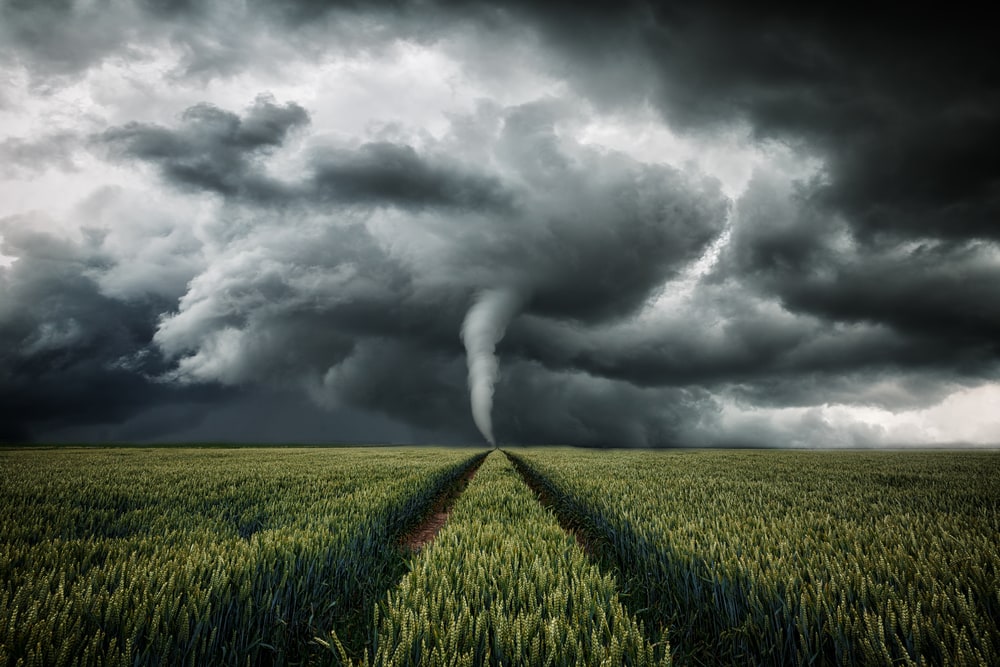
Tornadoes are powerful types of storms that can occur almost anywhere when conditions are right. Have you ever wondered where tornadoes come from and how they form?
Not all tornadoes are the same, each differing in size and strength. Find out more about these monstrous swirling storms in this complete guide on tornadoes!
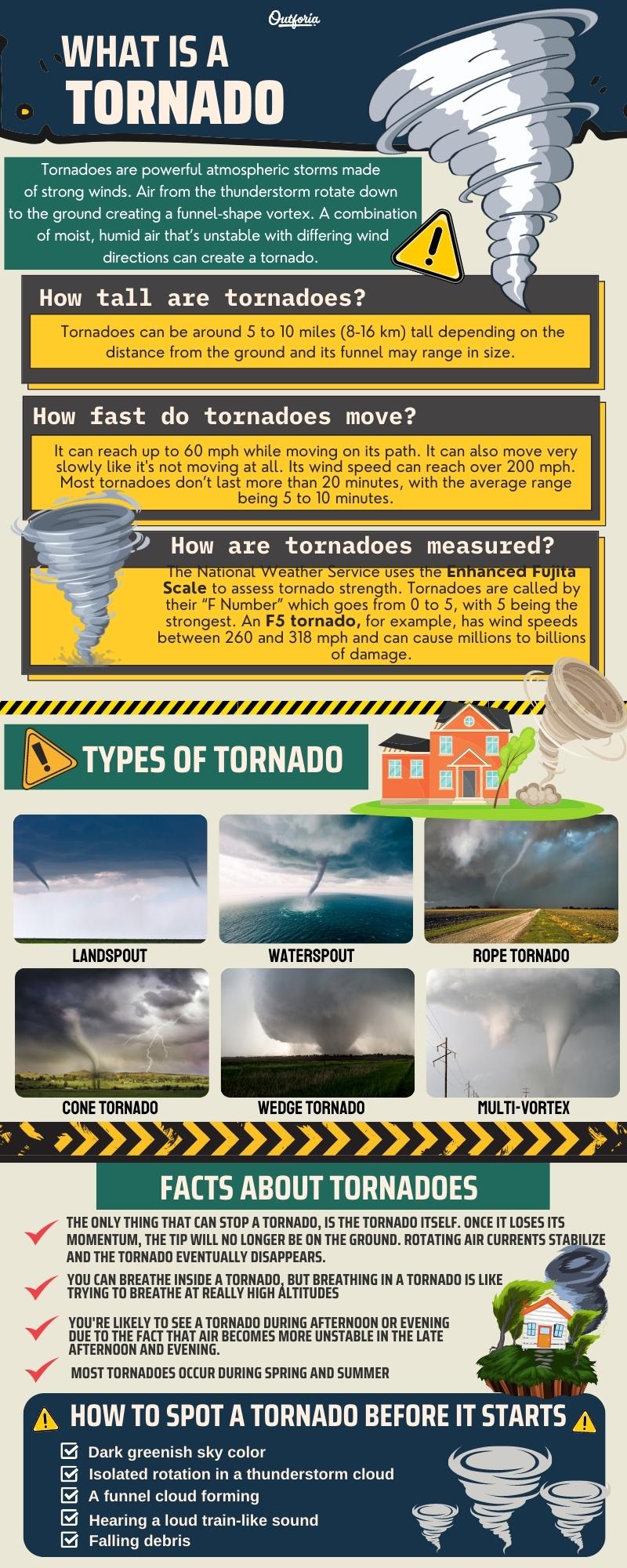
<a href="https://outforia.com/what-is-a-tornado/"><img style="width:100%;" src="https://outforia.com/wp-content/uploads/2022/09/what-is-a-tornado-infographic-0922.jpg"></a><br>what is a tornado <a href="https://outforia.com">Outforia</a>A tornado is a violent atmospheric storm made of strong winds. Columns of air rotate down to the ground from a thunderstorm, forming a funnel shape.
Collections of debris, dust, and water allow us to see the rotating winds of a tornado.
A tornado is made up of released energy in thunderstorms, creating powerful winds. There are several different types of tornadoes that have their own characteristics. Some tornadoes can be minor, while others can cause hefty damage.
Why Is It Called a Tornado?
The word tornado originates from the Latin word tonare. This means “to thunder.” Tronada is the Spanish word meaning thunderstorm. Tornado likely formed from a combination of tonare and tronada. It may have also been combined with tornar, which means “to turn” in Spanish.
Unlike hurricanes, tornadoes aren’t given names when they occur. Tropical storms and hurricanes are the only storm-type weather events that are given names.
What Do Tornadoes Look Like?
Tornadoes can look different depending on what type of tornado it is. Tornadoes are accompanied by dark storm clouds. These clouds form a swirling funnel that drops down.
The larger end of the funnel is in the thunderstorm cloud. The funnel usually gets skinnier towards the end that touches the ground. The part of the tornado touching the ground can be really skinny or almost as wide as the top.
How Tall are Tornadoes?
Tornadoes can be anywhere around 5 to 10 miles (8-16 km) tall. This range could depend on the distance between the ground and the thunderstorm cloud.
The funnel of a tornado can range in size. Some may be a few hundred meters wide, while others are much larger. The tip that touches the ground is usually skinnier than the top. But some tips of tornadoes can be over a mile wide.
How Fast Do Tornadoes Move?
There are two different speeds to consider when discussing how fast a tornado is moving.
The speed of a tornado can be measured by how fast it’s moving along its path. Speed can also be determined by how fast the rotating winds of a tornado are moving.
When referring to how fast a tornado moves in its path, it can reach up to 60 mph (97 kph) or more. A tornado can also move very slowly to the point where it may not even look like it’s moving.
Wind speeds in a tornado can reach over 200 mph (322 kph). Tornado strength is determined by wind speeds and damage caused to anything in its general path.
Strong tornadoes that do the most damage typically have wind speeds over 200 mph (322 kph). Weaker tornadoes can have wind speeds under 80 mph (129 kph).
How Long Do Tornadoes Last?
Tornadoes can be very short-lived or have longer ground time. Most don’t last more than 20 minutes, with the average range being 5 to 10 minutes.
Some can last more than an hour long if it has the strength and resources to do so. However, these strong tornadoes are rare.
How Much Damage Can a Tornado Do?
Tornadoes have different strength ratings depending on how much damage it causes. A tornado’s wind speed can be estimated by assessing the damage.
Tornadoes can rip up houses, trees, and anything in their path. They can cause immense damage if it builds up enough speed and wind power.
Some tornadoes may last longer than others. Tornadoes that aren’t as strong and don’t last long typically cause less damage. The National Weather Service uses the Enhanced Fujita Scale to assess tornado strength.
The rating system includes damage indicators. It allow experts to determine the wind speed rating of a tornado. Damage indicators include different types of infrastructure and trees. Experts will call tornadoes by their “F Number.” The F Number goes from 0 to 5, with 5 being the strongest.
The rating system measures how fast a tornado travels and wind gust speeds.
An F5 tornado, for example, has wind speeds between 260 and 318 mph (418 and 311 kph). F5 tornadoes can be extremely destructive. They have the ability to cause millions to billions of dollars in damage. They’re able to destroy concrete buildings and other solid infrastructure.
Weak tornadoes usually can’t damage buildings made of stronger materials. They can still cause damage to trees and homes.
Tornadoes can also cause indirect damage. Objects and debris picked up by strong tornadoes can be thrown elsewhere and damage other things in the process.
What Causes a Tornado
There are a few elements that go into what causes a tornado. Conditions like thunderstorms, warm and moist air, and air instability are the main ingredients that cause tornadoes.
In most cases, tornadoes cannot form without a thunderstorm. So the initial cause of a tornado is a thunderstorm with the right conditions to create a funnel cloud and tornado. Most thunderstorms don’t cause tornadoes, but it’s possible if all the components are there to make one.
You may also like: What Is An Avalanche? Know The Conditions, Causes & Dangers
How Do Tornadoes Form?
Scientists are still studying how tornadoes form to better understand them. There are a few different ways a tornado can form. In almost all tornado events, a thunderstorm is needed for a tornado to form.
There are two types of thunderstorms that form tornadoes. These include supercell and non-supercell thunderstorms. The type of thunderstorm also determines what kind of tornado could form.
Tornadoes form most often from supercell thunderstorms. A combination of moist, humid air that’s unstable with differing wind directions can create a tornado.
Winds lower to the ground can be moving in one direction. Meanwhile, winds higher up move in a different direction. This process is called wind shear.
The movement of cold air falling downward and humid air rising creates unstable air movement that begins to spin. The rising of the humid, moist, and rotating air is known as an updraft.
The direction of the air starts out by moving horizontally in the thunderstorm cloud. But when it begins moving vertically, it can create a funnel cloud. It’s not considered a tornado until it touches down on the ground. Otherwise, it stays a funnel cloud.
How Do You Spot a Tornado Before It Starts?
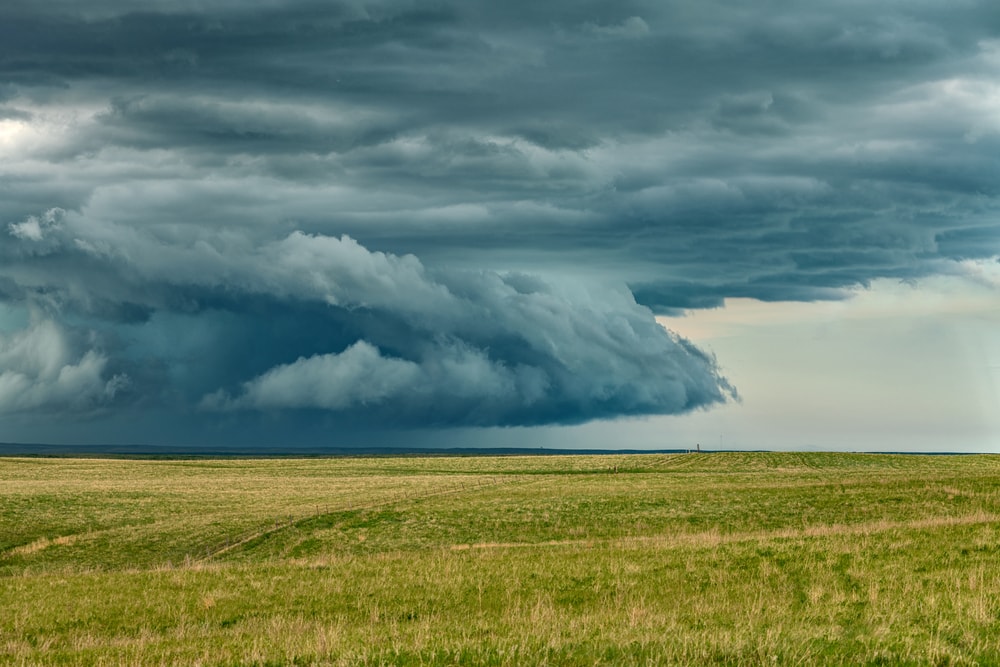
There are a few things you can look for to identify tornadoes before they begin. Some things you can look at that may lead to tornado formation include:
- Dark greenish sky color
- Isolated rotation in a thunderstorm cloud
- A funnel cloud forming
- Hearing a loud train-like sound
- Falling debris combined with some of the identifiers mentioned above
A funnel cloud forming is one of the clearest signs that a tornado is trying to appear. Even if you spot a funnel cloud, this doesn’t guarantee it will touch the ground, and a tornado will occur.
Some thunderstorm clouds get a dark greenish color before producing a tornado. However, strong thunderstorms may have this color as well. A fast-swirling thunderstorm cloud can signify that a funnel cloud is about to form.
The rapid rotation of air causes tornadoes to make sounds. Usually, it sounds like a loud train horn. It can also sound like a deep rumbling noise. The winds can also make other sounds.
If you hear the sound of a tornado and see a dark greenish sky with debris falling down, a tornado might be in the area.
You may also like: 24 Types Of Natural Disasters That You Need To Know
What Stops a Tornado?
The only thing that can stop a tornado is itself. Just as a tornado needs energy and resources to occur, it also needs them to maintain itself.
Tornadoes can happen very fast, but they can’t be stopped by a building, even if it’s super tall or made of concrete. As less air movement occurs, tornadoes begin to slow down. The continuous movement of humid air up and cold air down can cause tornadoes to go on for longer periods.
When a tornado loses its momentum, the tip will no longer be on the ground. Rotating air currents stabilize, and the tornado eventually disappears.
Types of Tornadoes
Each type of tornado falls under the supercell and non-supercell thunderstorm categories. Two types of non-supercell tornadoes include landspouts and waterspouts.
Other types of tornadoes form from a supercell thunderstorm, such as:
- Rope tornadoes
- Cone tornadoes
- Wedge tornadoes
- Multi-vortex tornadoes
Landspouts and waterspouts are weaker tornadoes. They usually don’t last as long as the others.
Landspout
Landspouts are very narrow tornadoes that have a rope-shaped funnel. These tornadoes can form when the thunderstorm cloud it’s forming from hasn’t fully developed yet. This causes it to get spinning momentum from the ground up rather than from the updraft at the top.
Waterspout
Waterspouts have very similar characteristics to landspouts. The one major difference is waterspouts occur over water.
Rope Tornado
Rope tornadoes look like ropes. They’re very thin and often have a very serpentine-like pattern. They can remain this way from the time they form until they disappear. Sometimes these tornadoes form their rope shape toward the end of their life.
Cone Tornado
A cone tornado has the classic tornado look. Its tip is thinner than the top of the tornado, forming a cone shape. These tornadoes can get pretty big, and if they do, they can cause much damage.
Wedge Tornado
Wedge tornadoes are extremely wide tornadoes. They typically look like a large wall of dark clouds. These types of tornadoes may have a wider tip touching the ground than the top of the tornado.
Although they’re larger than other tornadoes, this doesn’t mean they’re stronger.
Multi-vortex Tornado
Public Domain, https://commons.wikimedia.org/w/index.php?curid=846689
A multi-vortex tornado occurs when a main tornado is accompanied by another tornado. The second tornado may be similar or much smaller than the main tornado. This type of tornado event could include more than two tornadoes, but it’s extremely rare.
You may also like: What is Subsidence and How Does it Affect the Earth?
Historical Tornadoes
Tornadoes can be strong, disastrous event. There are some tornado events that break historical records for their power, speed, and damage caused.
Tri-State Tornado
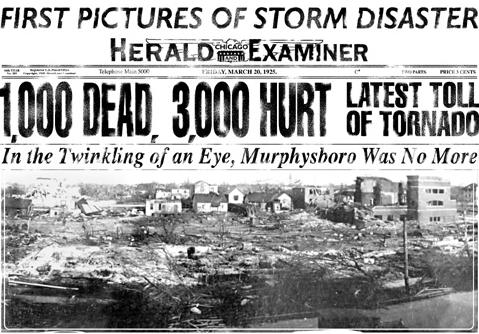
By A Herald Examiner journalist – English Wikipedia / Public Domain / Wikimedia commons
One of the deadliest tornadoes was the Tri-State Tornado of 1925. This tornado event occurred across three different states and caused damage to 13 counties. It went through the southern portions of Missouri, Illinois, and Indiana on March 18, 1925.
The Tri-State Tornado traveled 219 miles and had a width of almost one mile (1.6 km). It was graded as an F5 on the Fujita Scale. It traveled slightly over 60 mph (96.5 kph) and had wind speeds exceeding 300 mph (483 kph).
Great Plains Tornado Outbreak of 1999
Multi-vortex tornadoes occurred on May 3, 1999 in Oklahoma and Kansas. There were 74 tornadoes reported in the states within a 24-hour period.
The strongest tornado in the event reached record-breaking wind speeds over 300 mph (483 kph). It was rated as an F5 tornado.
Over 8,000 homes were damaged, and more than 800 people were injured, with 46 deaths.
March 2, 2012, Tornado Outbreak
On March 2, 2012, a devastating tornado outbreak occurred in 11 different states. There were 81 tornadoes present during this event, 18 of which were in Kentucky alone.
The tornado gained enough power and speed to be graded as an EF-4, the second-highest tornado ranking. Hail was also present from severe thunderstorms surrounding the affected areas.
There were more than 270 tornado warnings issued, and the event caused over $1.5 billion in damages. 41 people died as a result of the disastrous event.
Cyclone vs. Tornado: What’s the Difference?
Tornadoes are often referred to as cyclones, but they are different types of weather events. Tornadoes are considered small-scale cyclonic events.
Cyclones are large-scale rotating circulations in low atmospheric pressure and severe weather.
Winds circulate around low pressure during a cyclone. Tornadoes do the same, but they’re much smaller. Cyclones are more closely associated with hurricanes.
You may also like: 9 Different Types Of Weather: Facts, Definitions And Forecasting
Tornado vs. Hurricane: What’s the Difference?
A hurricane is a type of tropical storm that forms over the ocean. They’re often referred to as tropical cyclones. These weather events usually start over tropical or subtropical waters, where they build up power and wind speeds.
The maximum wind speed for a tropical storm to be classified as a hurricane is 74 mph (119 kph). When they hit land, they begin to lose power.
Hurricanes, tropical cyclones, and typhoons are the same things, but they’re referred to differently depending on where you are.
Hurricanes are tropical cyclones that occur in the North Atlantic and central and eastern North Pacific. It’s referred to as a typhoon in the Northwest Pacific. Areas around the Indian Ocean and South Pacific call them tropical cyclones.
The only tornadoes that form over water are waterspouts. These are considered small-scale storms. Tornadoes aren’t a type of tropical storm and are smaller weather events. This is what separates them from hurricanes.
Tornado Myths & Misconceptions
Tornadoes Don’t Form in Mountains – False
It’s a common misconception that tornadoes only form on flat land. However, they can occur in the mountains; it’s just less common.
What matters most for tornado formation is the weather conditions. This includes unstable air conditions and humidity. These conditions are common in the Great Plains, and it just so happens that the land there is flat.
Opening Windows Can Equalize the Pressure of a Tornado – False
Opening the windows in your house to try and equalize the pressure of an incoming tornado is a myth. It can actually be more damaging to your home if you open the windows during a tornado.
Houses don’t explode due to low pressure from a tornado. The strength of winds and flying debris can shatter windows, but they’re not exploding.
Big Tornadoes Are Stronger – Not Always!
Tornadoes can look massive but have weaker winds. The size of a tornado can be deceiving because its size doesn’t equal its strength.
Small rope tornadoes can still be destructive if they possess strong winds. A tornado’s strength can only be determined after its wind speeds and the amount of damage caused is assessed.
You may also like: Identifying The 10 Types Of Clouds (Pictures + Chart)
Tornado Facts
👉🏼 Tornadoes Occur Most in Spring and Summer
Tornadoes can occur any time of the year under the right conditions. However, they mostly occur during the spring and summer. This is because tornadoes need moisture and warm air to form.
👉🏼 You’re Most Likely to See a Tornado in the Afternoon or Evening
Air becomes more unstable in the late afternoon and evening. Warm air starts to mix with colder air as temperatures begin to drop. This causes warm air to rise quickly.
As a result, tornadoes are more likely to occur during these changes in air temperature and movement.
👉🏼 Tornadoes Don’t Usually Make Deep Trenches
You may have seen movies where tornadoes plow through the ground, creating trenches. Although it’s possible and has happened before, it’s not a common occurrence.
Tornado FAQs
Can you outrun a tornado?
No, you shouldn’t try to outrun a tornado. It’s very dangerous to be out in the open or in a vehicle during a tornado.
The Centers for Disease Control and Prevention (CDC) recommends finding the nearest shelter. If shelter isn’t nearby, you can seek shelter in a low-lying ditch and cover your head and neck.
Can you breathe inside a tornado?
Yes, you can breathe inside a tornado, but it’s difficult. Breathing in a tornado is like trying to breathe at really high altitudes. The air is less dense. This is why it’s hard to breathe if you go hiking at higher altitudes than you’re used to.
What to do if a tornado picks you up?
If you’re picked up by a tornado while in your home, it’s best to brace yourself and try to cover your head. A tornado can carry people and other things and throw them back out. You’ll want to prepare yourself for the impact if this happens.
How do I prevent being picked up by a tornado?
To prevent being picked up by a tornado, you’ll want to find a small room with little furniture, windows, or debris. Basements are recommended because they’re underground, and they’ll protect you if your house gets picked up. A cellar is also a good place to hide.
Which country has the most tornadoes?
While tornadoes can occur almost anywhere, the United States has the most tornadoes annually on average. The US usually experiences an average of about 1,200 tornadoes every year.
Why does it get quiet before a tornado?
Have you ever heard the saying “the calm before the storm”? This can happen when there’s less air movement, or wind, in the area. The air is rising as it’s being drawn in by the storm cell.
What’s the difference between a tornado watch and a tornado warning?
A tornado watch means that weather conditions in a specific area make it highly likely that a tornado could possibly form.
A tornado warning means that a Doppler weather radar has detected a thunderstorm that can produce a tornado in the area. It could also mean that a tornado has already formed and been identified.
Last Update: Jan 03, 2023
This is a question our experts keep getting from time to time. Now, we have got the complete detailed explanation and answer for everyone, who is interested!
Asked by: Gilbert Borer
Score: 4.7/5
(14 votes)
The word tornado is probably derived from the Spanish tronada («thunderstorm»). Tornadoes are also popularly called twisters or cyclones and are characterized by rapidly rotating columns of air hanging from cumulonimbus clouds. They are generally observed as tube- or funnel-shaped clouds.
Who invented the word tornado?
1550s, ternado, navigator’s word for violent windy thunderstorm in the tropical Atlantic, probably a mangled borrowing from Spanish tronada «thunderstorm,» from tronar «to thunder,» from Latin tonare «to thunder» (see thunder (n.)). Also in 17c.
What is tornado called in USA?
Tornadoes that are classified as EF4 and EF5 (or «violent tornadoes») on the Enhanced Fujita Scale only account for an average of two percent of all tornadoes in the United States each year.
Which is correct tornados or tornadoes?
The plural form of tornado is tornados or tornadoes. The plural of tornado is tornadoES.
What does this word mean tornado?
1a : a violent destructive whirling wind accompanied by a funnel-shaped cloud that progresses in a narrow path over the land. b : a squall accompanying a thunderstorm in Africa. 2 : a violent windstorm : whirlwind. 3 archaic : a tropical thunderstorm.
26 related questions found
What is tornado in simple words?
A tornado is a violent rotating column of air extending from a thunderstorm to the ground. The most violent tornadoes are capable of tremendous destruction with wind speeds of up to 300 mph. They can destroy large buildings, uproot trees and hurl vehicles hundreds of yards. They can also drive straw into trees.
Do tornadoes occur in England?
Around 30 tornadoes a year are reported in the UK. These are typically small and short-lived, but can cause structural damage if they pass over built-up areas.
Where is Tornado Alley?
Although the boundaries of Tornado Alley are debatable (depending on which criteria you use—frequency, intensity, or events per unit area), the region from central Texas, northward to northern Iowa, and from central Kansas and Nebraska east to western Ohio is often collectively known as Tornado Alley.
What is the plural for zero?
“Zero” is a number in the number system. The correct plural form for the noun “zero” accept would be option c, i.e. “zeroes”. It is formed by adding the suffix ‘-es’ towards the end of the noun “zero”.
What states have no tornadoes?
Bottom ten states with the least tornadoes
- Alaska — 0.
- Rhode Island — 0.
- Hawaii — 1.
- Vermont — 1.
- New Hampshire — 1.
- Delaware — 1.
- Connecticut — 2.
- Massachusetts — 2.
When was the last f5 tornado in the United States?
The nation’s most recent EF5 ripped across hapless Moore, Oklahoma, on May 20, 2013.
Can you breathe inside a tornado?
Researchers estimate that the density of the air would be 20% lower than what’s found at high altitudes. To put this in perspective, breathing in a tornado would be equivalent to breathing at an altitude of 8,000 m (26,246.72 ft). At that level, you generally need assistance to be able to breathe.
What was the first tornado?
The first possible tornado report in the United States occurred in July 1643 in Lynn, Newbury, and Hampton, Massachusetts, documented by author David Ludlam.
Has anyone survived the eye of a tornado?
Missouri – Matt Suter was 19 years old when he had an experience that he will never forget. He survived after being swept up inside a tornado. … More than a dozen tornadoes spawned from the supercell thunderstorms that day, claiming the lives of two people. But Matt was lucky.
What are the 5 stages of a tornado?
What are the 5 stages of a tornado?
- Dust-Whirl Stage. Dust swirling upwards from the ground and grows toward the funnel cloud in the sky.
- Organizing Stage. Downward extend of funnel and “connection” with dust-whirl on the ground.
- Mature Stage. Tornado on the ground.
- Shrinkage Stage.
- Decaying Stage.
What state has the worst tornadoes?
The top 10 worst states for tornadoes
- Texas. Texas had the most tornadoes in 2019, reporting 188 tornadoes. …
- Oklahoma. Oklahoma is another hard-hit state, with 99 reported tornadoes in 2019. …
- Missouri. …
- Louisiana. …
- Alabama. …
- Georgia. …
- North Carolina. …
- Ohio.
Where do most tornadoes occur?
Most tornadoes are found in the Great Plains of the central United States – an ideal environment for the formation of severe thunderstorms. In this area, known as Tornado Alley, storms are caused when dry cold air moving south from Canada meets warm moist air traveling north from the Gulf of Mexico.
Why does America have so many tornadoes?
The high frequency of tornadoes in North America is largely due to geography, as moisture from the Gulf of Mexico is easily advected into the midcontinent with few topographic barriers in the way.
What was the biggest tornado in history?
The deadliest tornado of all time in the United States was the Tri-State Tornado on March 18, 1925 in Missouri, Illinois and Indiana. It killed 695 people and injured over 2,000.
What is the biggest tornado ever?
The deadliest: The Tristate Tornado, March 8th, 1925
The tornado was approximately . 75 miles wide and traveled a staggering 219 (newer research suggests it had a continual path of at least 174 miles) at a 59 mph pace. It caused 695 fatalities and destroyed over 15,000 homes.
How does a tornado form?
Tornadoes form when warm, humid air collides with cold, dry air. The denser cold air is pushed over the warm air, usually producing thunderstorms. The warm air rises through the colder air, causing an updraft. … When it touches the ground, it becomes a tornado.
1
a
: a violent destructive whirling wind accompanied by a funnel-shaped cloud that progresses in a narrow path over the land
b
: a squall accompanying a thunderstorm in Africa
3
archaic
: a tropical thunderstorm
Example Sentences
Recent Examples on the Web
Micaela Vargas said her experience with the Montebello tornado was frightening.
—
The National Weather Service confirmed the tornado on Wednesday afternoon in a statement posted to Twitter.
—
Preliminary reports classified the tornado as an EF1, meaning winds reached up to 110 mph.
—
More than 120,000 people were still without power on the Monday following the storm that also caused an EF-2 tornado in Fremont.
—
Selma officials hope Biden will also address the January tornado that devastated the city and laid bare issues of poverty that have persisted in Selma for decades.
—
Preliminary survey information from the National Weather Service office in Norman has confirmed the tornado Sunday night was at least an EF-2.
—
The tornado was reported in Troup County between 4:20 a.m. and 4:30 a.m., according to the National Weather Service.
—
In Deer Park, a Shell chemicals plant reported ‘flaring’ due to damage caused by the tornado.
—
See More
These examples are programmatically compiled from various online sources to illustrate current usage of the word ‘tornado.’ Any opinions expressed in the examples do not represent those of Merriam-Webster or its editors. Send us feedback about these examples.
Word History
Etymology
modification of Spanish tronada thunderstorm, from tronar to thunder, from Latin tonare — more at thunder entry 1
First Known Use
1556, in the meaning defined at sense 3
Time Traveler
The first known use of tornado was
in 1556
Dictionary Entries Near tornado
Cite this Entry
“Tornado.” Merriam-Webster.com Dictionary, Merriam-Webster, https://www.merriam-webster.com/dictionary/tornado. Accessed 14 Apr. 2023.
Share
More from Merriam-Webster on tornado
Last Updated:
26 Mar 2023
— Updated example sentences
Subscribe to America’s largest dictionary and get thousands more definitions and advanced search—ad free!
Merriam-Webster unabridged
Other forms: tornadoes; tornados
A tornado is a violent windstorm in the shape of a funnel cloud that reaches to the ground. If a tornado is coming, you’ll want to take cover.
A tornado can be quite severe and leave a lot of destruction in its wake, Tornadoes (or tornados — either is correct) tend to occur more often and with more severity in areas over flat lands, such as the Great Plains. That Kansas “twister” in The Wizard of Oz is a famous example of a tornado. Tornado is sometimes used to describe someone or something that acts like a tornado — with intense, violent energy or emotion.
Definitions of tornado
-
noun
a localized and violently destructive windstorm occurring over land characterized by a funnel-shaped cloud extending toward the ground
-
synonyms:
twister
see moresee less-
types:
-
supertwister
the most powerful tornado which can create enormously devastating damage
-
waterspout
a tornado passing over water and picking up a column of water and mist
-
type of:
-
cyclone
a violent rotating windstorm
-
supertwister
-
noun
a purified and potent form of cocaine that is smoked rather than snorted; highly addictive
see moresee less-
type of:
-
cocain, cocaine
a narcotic (alkaloid) extracted from coca leaves; used as a surface anesthetic or taken for pleasure; can become powerfully addictive
-
cocain, cocaine
DISCLAIMER: These example sentences appear in various news sources and books to reflect the usage of the word ‘tornado’.
Views expressed in the examples do not represent the opinion of Vocabulary.com or its editors.
Send us feedback
EDITOR’S CHOICE
Look up tornado for the last time
Close your vocabulary gaps with personalized learning that focuses on teaching the
words you need to know.
Sign up now (it’s free!)
Whether you’re a teacher or a learner, Vocabulary.com can put you or your class on the path to systematic vocabulary improvement.
Get started
Meaning Tornado
What does Tornado mean? Here you find 80 meanings of the word Tornado. You can also add a definition of Tornado yourself
1 |
0 A vortex of rapidly moving air associated with some severe thunderstorms. Winds within the tornado funnel may exceed 500 kilometers per hour.
|
2 |
0 TornadoA violently rotating column of air, usually pendant to a cumulonimbus, with circulation reaching the ground. It nearly always starts as a funnel cloud and may be accompanied by a loud roaring noise. O [..]
|
3 |
0 Tornado1550s, ternado, navigator’s word for violent windy thunderstorm in the tropical Atlantic, probably a mangled borrowing from Spanish tronada «thunderstorm,» from tronar «to thunder, [..]
|
4 |
0 TornadoAn intense, rotating column of air that protrudes from a cumulonimbus cloud in the shape of a funnel or a rope and touches the ground. (See Funnel cloud.)
|
5 |
0 Tornadoa violently rotating column of air that forms at the bottom of a cloud and touches the ground.
|
6 |
0 TornadoA rotating column of air, in contact with the surface, pendant from a cumuliform cloud, and often visible as a funnel cloud and/or circulating debris/dust at the ground. On a local scale, the tornado [..]
|
7 |
0 TornadoA whirlwind or mass of rotating air with high wind speeds at its center.
|
8 |
0 Tornadoa localized and violently destructive windstorm occurring over land characterized by a funnel-shaped cloud extending toward the ground crack: a purified and potent form of cocaine that is smoked rathe [..]
|
9 |
0 Tornadoa localized, anti-clockwise spiral of wind with extremely violent wind speed and uplift.
|
10 |
0 TornadoA violent rotating column of air, in contact with the ground, pendant from a cumulonimbus cloud. A tornado does not require the visible presence of a funnel cloud. It has a typical width of tens to hu [..]
|
11 |
0 TornadoA small but extremely violent storm. The distinctive funnel clouds descend to the ground from the base of a thundercloud and can be up to 100 metres at the base.
|
12 |
0 TornadoIf you dream that you are in a tornado, you will be filled with disappointment and perplexity over the miscarriage of studied plans for swift attainment of fortune. See Hurricane.
|
13 |
0 Tornado(n) — a narrow, cyclonic storm with very high wind speeds
|
14 |
0 TornadoA destructive windstorm occurring over land, characterized by a funnel-shaped cloud extending toward the ground.
|
15 |
0 TornadoA destructive, whirling, funnel-shaped cloud that has extremely low air pressure.
|
16 |
0 TornadoA violent storm characterized by a funnel-shaped cloud and high winds.
|
17 |
0 Tornadodestructive, rotating column of air that has very high wind speeds and that may be visible as a funnel-shaped cloud. total eclipse —
|
18 |
0 TornadoA rotating column of air usually accompanied by a funnel-shaped downward extension of a cumulonimbus cloud and having a vortex several hundred yards in diameter whirling destructively at speeds of up to 500 miles (800 kilometers) per hour.
|
19 |
0 Tornado(n) a localized and violently destructive windstorm occurring over land characterized by a funnel-shaped cloud extending toward the ground(n) a purified and potent form of cocaine that is smoked rat [..]
|
20 |
0 TornadoConcentrated storms that are characterized by a funnel-shaped cloud and extreme winds (Lesson 28)
|
21 |
0 TornadoA violent rotating column of air, extending from the base of a cumulonimbus cloud to the ground, producing damaging winds up to 300 mph. TROPICAL DEPRESSION: A tropical cyclone in which the maximum 1- [..]
|
22 |
0 TornadoA violent rotating column of air, in contact with the ground, pendant from a cumulonimbus cloud. A tornado does not require the visible presence of a funnel cloud. It has a typical width of tens to hu [..]
|
23 |
0 TornadoA violently rotating column of air in contact with and extending between a convective cloud and the surface of the earth. It is the most destructive of all storm-scale atmospheric phenomena. They can [..]
|
24 |
0 TornadoRotating column of air extending from a thunderstorm to the ground. Tornadoes generally produce damage paths of 100 yards wide or less, with path lengths of a couple miles.
|
25 |
0 TornadoA violently rotating column of air that reaches from the base of a cloud to the ground.
|
26 |
0 TornadoWhirlwind having a diameter of less than a quarter of a mile, and a speed of travel of about 30 knots. Wind velocity may exceed 200 knots. Local effects may be disastrous.
|
27 |
0 TornadoA whirling wind over land, accompanied by a funnel-shaped cloud. It is usually very violent and destructive in a narrow path, often for many miles.
|
28 |
0 TornadoA twisting, spinning funnel of low pressure air. The most unpredictable weather event, tornadoes are created during powerful thunderstorms. As a column of warm air rises, air rushes in at ground level [..]
|
29 |
0 TornadoA rotating column of air usually accompanied by a funnel-shaped downward extension of a cumulonimbus cloud and having a vortex several hundred yards in diameter whirling destructively at speeds of up to 500 miles (800 kilometers) per hour.
|
30 |
0 TornadoA violently rotating column of air in contact with the ground and extending from the base of a thunderstorm. A condensation funnel does not need to reach to the ground for a tornado to be present; a debris cloud beneath a thunderstorm is all that is needed to confirm the presence of a tornado, even in the total absence of a condensation funnel. It [..]
|
31 |
0 TornadoRapidly spinning wind shaped like a cone or funnel. Conditions are ripe for tornadoes when the air becomes unstable inside a big thunderstorm, with blowing winds creating rolling air currents. When it [..]
|
32 |
0 TornadoA violently rotating column of air, usually pendant to a cumulonimbus, with circulation reaching the ground. It nearly always starts as a funnel cloud and may be accompanied by a loud roaring noise. On a local scale, it is the most destructive of all atmospheric phenomena.
|
33 |
0 TornadoA rotating column of air that stretches from the base of a cumulonimbus or towering cumulus cloud. This is the most intense atmospheric phenomena and takes the shape of a funnel cloud. A tornado develops from a funnel cloud with strong and violent rotation that extends entirely to the surface. Upon impact with the ground, strong winds associated wi [..]
|
34 |
0 TornadoA rapidly rotating column of air extending from a cumulonimbus cloud with a circulation that reaches the ground. However, the visible portion might not extend all the way to the ground. Tornado Warnin [..]
|
35 |
0 TornadoA violently rotating column of air in contact with the ground and extending from the base of a thunderstorm. A condensation funnel does not need to reach to the ground for a tornado to be present; a debris cloud beneath a thunderstorm is all that is needed to confirm the presence of a tornado, even in the total absence of a condensation funnel.
|
36 |
0 TornadoAn intense, rotating column of air that protrudes from a cumulonimbus cloud in the shape of a funnel or a rope whose circulation is present on the ground.
|
37 |
0 TornadoA rotating column of air, usually accompanied by a funnel shaped downward extension of a cumulonimbus cloud, perhaps several hundred yards or more in diameter, whirling destructively at speeds sometimes in excess of 300 miles per hour. Also called a twister.
|
38 |
0 TornadoA violently rotating column of air in contact with the ground. It typically forms from a thunderstorm. Tornadoes are ranked F0 to F5 on the Fujita Tornado Intensity Scale based on their intensity and [..]
|
39 |
0 TornadoA rapidly rotating column of air extending from a cumulonimbus cloud with a circulation that reaches the ground.
|
40 |
0 TornadoA violently rotating column of air, in contact with the surface, pendant from a cumuliform cloud, and often (but not always) visible as a funnel cloud. Wind speeds are sometimes estimated on the basis [..]
|
41 |
0 TornadoA violently rotating column of air in contact with and extending between a convective cloud and the surface of the earth. It is the most destructive of all storm-scale atmospheric phenomena. They can occur anywhere in the world given the right conditions, but are most frequent in the United States in an area bounded by the Rockies on the west and t [..]
|
42 |
0 TornadoA violently rotating column of air, usually pendant to a cumulonimbus, with circulation reaching the ground. It nearly always starts as a funnel cloud and may be accompanied by a loud roaring noise. O [..]
|
43 |
0 TornadoA small mass of air that whirls rapidly about an almost vertical axis; made visible by clouds and by dust and debris sucked into the system.
|
44 |
0 TornadoA violent rotating column of air, usually forming a pendant from a cumulonimbus cloud with the circulation reaching the ground. It nearly always starts as a funnel cloud and may be accompanied by a loud roaring noise. On a local scale, it is the most destructive of all atmospheric phenomena.
|
45 |
0 TornadoA violently rotating column of air in contact with and extending between a convective cloud and the surface of the earth. It is the most destructive of all storm-scale atmospheric phenomena. They can [..]
|
46 |
0 TornadoA violently rotating column of air that is in contact with the ground. Sometimes a condensation funnel is not obvious for the entire length, cloud to ground, but even so, a debris cloud will be visibl [..]
|
47 |
0 TornadoA violently rotating column of air in contact with the ground and extending from the base of a thunderstorm. A condensation funnel does not need to reach to the ground for a tornado to be present; a d [..]
|
48 |
0 TornadoA violently rotating column of air in contact with and extending between a convective cloud and the surface of the earth. It is the most destructive of all storm-scale atmospheric phenomena. They can [..]
|
49 |
0 TornadoA violent, funnel-shaped rotating column of air that has contact with the earth’s surface and is extended from a thunderstorm base.
|
50 |
0 TornadoA violently rotating column of air in contact with and extending between a convective cloud and the surface of the earth. It is the most destructive of all storm-scale
|
51 |
0 TornadoTornadoes are rapidly rotating columns of air that blow around a small area of intense low pressure. A Tornado in circulation is present on the ground either as a funnel shaped cloud or a swirling cloud of dust and debris. Some Tornadoes never reach the ground, and they appear to hang from a parent cloud as a rapidly rotating funnel. Most tornadoes [..]
|
52 |
0 TornadoA violently rotating column of air, usually pendant to a cumulonimbus, with circulation reaching the ground. It nearly always starts as a funnel cloud and may be accompanied by a loud roaring noise. O [..]
|
53 |
0 TornadoA strong, rotating column of air extending from the base of a cumulonimbus cloud to
|
54 |
0 TornadoA violently rotating column of air in contact with and extending between a convective cloud and the surface of the earth. It is the most destructive of all storm-scale atmospheric phenomena. They can occur anywhere in the world given the right conditions, but are most frequent in the United States in an area bounded by the Rockies on the west and t [..]
|
55 |
0 TornadoThe Tornado is a double handed multihull class recognised as an International Class by the International Sailing Federation. It was used for the Catamaran discipline at the Olympic Games from 1976 to [..]
|
56 |
0 TornadoA tornado is a violently rotating column of air that is in contact with both the surface of the Earth and a cumulonimbus cloud or, in rare cases, the base of a cumulus cloud. It is often referred to a [..]
|
57 |
0 TornadoThe Tornado is a double handed multihull class recognised as an International Class by the International Sailing Federation. It was used for the Catamaran discipline at the Olympic Games from 1976 to [..]
|
58 |
0 TornadoA tornado is a violent rotating column of air that touches the surface of the earth.
|
59 |
0 TornadoA tornado is a violent rotating column of air that touches the surface of the earth.
|
60 |
0 TornadoTornado was a short-lived weekly British comic magazine published for 22 issues by IPC Magazines between March 1979 and August 1979. After the cancellations of the Starlord and Action titles, IPC laun [..]
|
61 |
0 TornadoTornado was a short-lived weekly British comic magazine published for 22 issues by IPC Magazines between March 1979 and August 1979. After the cancellations of the Starlord and Action titles, IPC laun [..]
|
62 |
0 TornadoTornado was a competitor on the UK TV series Robot Wars, noteworthy as the champion of the sixth series. It was built by Andrew Marchant, Bryan Moss and David Gamble, from Sawtry, near Huntingdon.
|
63 |
0 TornadoTornado was a competitor on the UK TV series Robot Wars, noteworthy as the champion of the sixth series. It was built by Andrew Marchant, Bryan Moss and David Gamble, from Sawtry, near Huntingdon.
|
64 |
0 TornadoTornado (occasionally Toronado) is a horse ridden by the character Zorro in several films and books. Tornado is said to be intelligent and fast. His name is pronounced in the Spanish way, «tor-NAH-do» [..]
|
65 |
0 TornadoThe Tornado is a wooden roller coaster located at Adventureland in Altoona, Iowa, near Des Moines.
|
66 |
0 TornadoA tornado is a violently rotating column of air that is in contact with both the surface of the Earth and a cumulonimbus cloud or, in rare cases, the base of a cumulus cloud. It is often referred to a [..]
|
67 |
0 TornadoA tornado is a violently rotating column of air that is in contact with both the surface of the Earth and a cumulonimbus cloud or, in rare cases, the base of a cumulus cloud. It is often referred to a [..]
|
68 |
0 TornadoTornado is a 1943 film directed by William A. Berke and starring Chester Morris and Nancy Kelly.
|
69 |
0 TornadoTornado is a combat flight simulator video game by Digital Integration that models the Panavia Tornado. It was released in 1993 for DOS and Amiga. Tornado is one of the first flight simulations to off [..]
|
70 |
0 TornadoSteve Debbes (born April 3, 1966), better known by his ring name Tornado, is a South African professional wrestler performing for World Wrestling Professionals. He is a 2-time WWP Heavyweight World Ch [..]
|
71 |
0 TornadoTornado (1996) is a children’s book by Betsy Byars, illustrated by Doron Ben-Ami.
|
72 |
0 TornadoThe Tornado is an amusement ride manufactured by Wisdom Industries Ltd. Most Tornadoes travel with a traveling midway company to many fairs with many other rides.
|
73 |
0 TornadoTornado is a video game for the Nintendo DS handheld gaming system, developed by South Korean studio SKONEC Entertainment and published by Ignition Entertainment. The game tasks you as Toki, a member [..]
|
74 |
0 TornadoTornado is brand of table football (foosball) table that has been used in the World Championships since 1986. The original Tornado model was created by engineer Bob Furr. The Tornado brand has been m [..]
|
75 |
0 TornadoTornado (formerly known as Bobs) was a roller coaster located at Coney Island along Bowery Street in Brooklyn, New York City. Designed by Fred Church and built by the L. A. Thompson Company, the roll [..]
|
76 |
0 TornadoTornado is a scalable, non-blocking web server and web application framework written in Python. It was developed for use by FriendFeed; the company was acquired by Facebook in 2009 and Tornado was ope [..]
|
77 |
0 TornadoA tornado is a violent rotating column of air that touches the surface of the earth.
|
78 |
0 TornadoThe Tornado is a water slide manufactured by ProSlide Technology. It requires riders to sit in a 2-6 seater round tube. Riders drop from inside a tunnel out into the ride’s main element shaped like a [..]
|
79 |
0 Tornado«Tornado» is a song recorded by American country music group Little Big Town. It was released in October 2012 as the second single from their fifth studio album, Tornado. The song was written by Nata [..]
|
80 |
0 TornadoThe Tornado is a steel inverted roller coaster at the Parque de Atracciones de Madrid in Casa de Campo, Madrid, Spain. Manufactured by Intamin, it opened on May 23, 1999.
|
Dictionary.university is a dictionary written by people like you and me.
Please help and add a word. All sort of words are welcome!
Add meaning
-
1
tornado
Персональный Сократ > tornado
-
2
tornado
English-Russian aviation dictionary > tornado
-
3
tornado
[tɔ:ʹneıd|əʋ]
(pl -oes, -os [-{tɔ:ʹneıd}əʋz]
2) ураган
2. взрыв, ураган, вихрь, шквал
a tornado of words — словоизвержение; ≅ его словно прорвало
a great tornado of applause /of cheers/ — взрыв /буря, шквал/ аплодисментов
3.
яхта международного класса типа «Торнадо»
НБАРС > tornado
-
4
tornado
1. n метеор. смерч, торнадо
2. n ураган
3. n взрыв, ураган, вихрь, шквал
4. n спорт. яхта международного класса типа «Торнадо»
Синонимический ряд:
English-Russian base dictionary > tornado
-
5
tornado
Англо-русский синонимический словарь > tornado
-
6
tornado
- торнадо
торнадо
—
[ http://www.eionet.europa.eu/gemet/alphabetic?langcode=en]EN
tornado
A rapidly rotating column of air developed around a very intense low-pressure centre. It is associated with a dark funnel-shaped cloud and with extremely violent winds (>300km/h) blowing in a counterclockwise spiral, but accompanied by violent downdraughts. The precise mechanisms are not fully understood but the following atmospheric conditions appear to be necessary for tornado development: a layer of warm moist air at low altitude; a layer of dry air at higher altitude with an inversion of temperature at about 1.000 m; a triggering mechanism, usually in the form of an active, intense cold front or solar heating of the ground which will create a vortex. (Source: WHIT)
[http://www.eionet.europa.eu/gemet/alphabetic?langcode=en]Тематики
- охрана окружающей среды
EN
- tornado
DE
- Tornado
FR
- tornade
Англо-русский словарь нормативно-технической терминологии > tornado
-
7
tornado
English-Russian dictionary on nuclear energy > tornado
-
8
tornado
tɔ:ˈneɪdəu исп.;
сущ. смерч, торнадо, шквал Syn: wind
(метеорология) смерч, торнадо;
ураган взрыв, ураган, вихрь, шквал — a * of words словоизвержение;
его словно прорвало — a * of work (was in her) демон деятельности (вселился в нее) — * of anger взрыв негодования — the last * of monadism последняя волна кочевничества — a magnificent * of colours блестящий фейерверк красок — a great * of applause /of cheers/ взрыв /буря, шквал/ аплодисментов (спортивное) яхта международного класса типа «Торнадо»
tornado (pl -oes, -os) исп. торнадо, шквал, смерчБольшой англо-русский и русско-английский словарь > tornado
-
9
tornado
English-Russian dictionary of regional studies > tornado
-
10
tornado
торнадо (вихрь, сопровождаемый ливнем)
Англо-русский морской словарь > tornado
-
11
tornado
English-Russian big medical dictionary > tornado
-
12
tornado
[tɔ:ˈneɪdəu]
tornado (pl -oes, -os) исп. торнадо, шквал, смерч
English-Russian short dictionary > tornado
-
13
tornado
English-Russian dictionary of geology > tornado
-
14
tornado
Англо-русский технический словарь > tornado
-
15
tornado
[tɔː’neɪdəʊ]
1) Общая лексика: буря , взрыв, вихрь, метео грозный шквал, сильный ураган, сильный шквал, ураган
2) Морской термин: торнадо , тропический ураган
Универсальный англо-русский словарь > tornado
-
16
tornado
[tɔː`neɪdəʊ]
смерч, торнадо, шквал
Англо-русский большой универсальный переводческий словарь > tornado
-
17
tornado
Англо-русский словарь по гражданской авиации > tornado
-
18
tornado
Англо-русский словарь нефтегазовой промышленности > tornado
-
19
tornado
span.
noun
торнадо, шквал, смерч
Syn:
wind
* * *
2 (n) взрыв; смерч; торнадо; ураган; шквал; яхта международного класса типа торнадо
* * *
смерч, торнадо, шквал
* * *
[tor·na·do || tɔr’neɪdəʊ /tɔː-]
смерч, торнадо, ураган, вихрь, шквал* * *
Новый англо-русский словарь > tornado
-
20
tornado
торнадо, грозный шквал, смерч
США. Лингвострановедческий англо-русский словарь > tornado
Страницы
- Следующая →
- 1
- 2
- 3
- 4
- 5
- 6
- 7
См. также в других словарях:
-
Tornado — Tornado, 1949 in Kansas (USA) Ein Tornado (spanisch tornar „umkehren, wenden, drehen“, Partizip tornado; tornear „wirbeln, drechseln“), auch Großtrombe, Wind oder Wasserhose, in den USA umgangssprachlich auch Twister genannt, ist ein… … Deutsch Wikipedia
-
Tornado — Sm Wirbelsturm erw. exot. (18. Jh.) Entlehnung. Entlehnt aus span. tornado, zu span. tornar drehen , dieses aus l. tornāre drehen, drechseln . Ebenso nndl. tornado, ne. tornado, nfrz. tornade, nschw. tornado, nnorw. tornado; Tour. ✎ Jones… … Etymologisches Wörterbuch der deutschen sprache
-
Tornado! — is a made for TV movie starring Bruce Campbell and Shannon Sturges, released on May 7, 1996. It was written by John Logan and directed by Noel Nosseck. PlotThe movie s main character is storm chaser Jake Thome (Bruce Campbell), whose friend Dr.… … Wikipedia
-
Tornado — Tornado, WV U.S. Census Designated Place in West Virginia Population (2000): 1111 Housing Units (2000): 437 Land area (2000): 3.595035 sq. miles (9.311097 sq. km) Water area (2000): 0.084938 sq. miles (0.219989 sq. km) Total area (2000): 3.679973 … StarDict’s U.S. Gazetteer Places
-
Tornado, WV — U.S. Census Designated Place in West Virginia Population (2000): 1111 Housing Units (2000): 437 Land area (2000): 3.595035 sq. miles (9.311097 sq. km) Water area (2000): 0.084938 sq. miles (0.219989 sq. km) Total area (2000): 3.679973 sq. miles… … StarDict’s U.S. Gazetteer Places
-
tòrnādo — (tornȃdo) m meteor. zračni vrtlog razorne snage, spušta se iz jako razvijenog kumulonimbusa u obliku tamnog, gotovo vertikalnog stupa širine od nekoliko metara do nekoliko stotina metara, osobito česta pojava u nekim državama SAD a; tvister ✧… … Veliki rječnik hrvatskoga jezika
-
tornado — s.m. [dall ingl. tornado, adattam. dello sp. tronada, der. di tronar tuonare ma inteso come part. pass. di tornar girare ], invar. (meteor.) [movimento turbinoso d aria molto violento, frequente negli Stati Uniti orientali] ▶◀ ciclone, tromba d… … Enciclopedia Italiana
-
tornado — tòrnādo (tornȃdo) m DEFINICIJA meteor. zračni vrtlog razorne snage, spušta se iz jako razvijenog kumulonimbusa u obliku tamnog, gotovo vertikalnog stupa širine od nekoliko metara do nekoliko stotina metara, osobito česta pojava u nekim državama… … Hrvatski jezični portal
-
Tornado — Tornado: Die Bezeichnung für einen tropischen Wirbelsturm in Nordamerika und Westafrika wurde im 18. Jh. aus span. tornado »Wirbelsturm« entlehnt, einer Bildung zu span. tornar (< lat. tornare) »drehen«. Über weitere etymologische… … Das Herkunftswörterbuch
-
tornado — (Del ingl. tornado, y este del esp. tronada). m. huracán (ǁ viento a modo de torbellino) … Diccionario de la lengua española
-
Tornado — Tor*na do, n.; pl. {Tornadoes}. [From Sp. or Pg. tornar to turn, return, L. tornare to turn, hence, a whirling wind. The Sp. & Pg. tornada is a return. See {Turn}.] A violent whirling wind; specifically (Meteorol.), a tempest distinguished by a… … The Collaborative International Dictionary of English
Table of Contents
- Who invented the word tornado?
- What language is tornado?
- Is tornado pronounced or tornado?
- How do you spell destroyed?
- Does destroy mean kill?
- What is destruct?
- What is destroy in English?
- What is to destroy someone?
- What does ravage mean?
- What does ravishing your body mean?
- Is Ravager a word?
- What does vague mean?
- Is everyone a vague word?
- Whats vague responses mean?
- What’s another word for vague?
- What is opposite word of vague?
- What is the most nearly opposite of vague?
- How do you describe vague?
- What does Foresight mean?
- Does vague mean unclear?
- How do you use the word vague in a sentence?
- What does exasperation mean?
- What is an example of vague?
- What does bewildered mean?
- Is bewilderment an emotion?
- What is a vulgar language?
1a : a violent destructive whirling wind accompanied by a funnel-shaped cloud that progresses in a narrow path over the land. b : a squall accompanying a thunderstorm in Africa. 2 : a violent windstorm : whirlwind.
Who invented the word tornado?
1550s, ternado, navigator’s word for violent windy thunderstorm in the tropical Atlantic, probably a mangled borrowing from Spanish tronada “thunderstorm,” from tronar “to thunder,” from Latin tonare “to thunder” (see thunder (n.)). Also in 17c.
What language is tornado?
Portuguese
Is tornado pronounced or tornado?
Fun Fact: the correct pronunciation of Tornado is torNAYdo, like the storm, not torNAHdo!
How do you spell destroyed?
Correct spelling for the English word “destroyed” is [dɪstɹˈɔ͡ɪd], [dɪstɹˈɔɪd], [d_ɪ_s_t_ɹ_ˈɔɪ_d] (IPA phonetic alphabet)….Similar spelling words for DESTROYED
- dextrorotary,
- destress,
- dextrously,
- destroy,
- dexter,
- dextrose,
- dexterity,
- destroyable,
Does destroy mean kill?
verb (used with object) to kill; slay. to render ineffective or useless; nullify; neutralize; invalidate. to defeat completely.
What is destruct?
de·struct | / ˈdēˌstrəkt, də̇ˈs-, dēˈs- / plural -s. Definition of destruct (Entry 2 of 2) : the deliberate destruction of a rocket after launching especially during a test also : destruction of a device or material (as to prevent its falling into enemy hands)
What is destroy in English?
: to cause (something) to end or no longer exist : to cause the destruction of (something) : to damage (something) so badly that it cannot be repaired. : to kill (an animal) especially because it is sick, injured, or dangerous. informal : to defeat (someone or something) easily or completely.
What is to destroy someone?
transitive verb. To destroy someone means to ruin their life or to make their situation impossible to bear.
What does ravage mean?
ravage, devastate, waste, sack, pillage, despoil mean to lay waste by plundering or destroying. ravage implies violent often cumulative depredation and destruction.
What does ravishing your body mean?
: unusually attractive, pleasing, or striking.
Is Ravager a word?
ravages Destructive or harmful effects: the ravages of disease. [French ravager, from Old French, to uproot, from ravir, to ravish; see ravish.] rav′ag·er n.
What does vague mean?
1a : not clearly expressed : stated in indefinite terms vague accusations. b : not having a precise meaning a vague term of abuse. 2a : not clearly defined, grasped, or understood : indistinct only a vague notion of what’s needed also : slight a vague hint of a thickening waistline hasn’t the vaguest idea.
Is everyone a vague word?
What kinds of words would be considered vague? Nouns that are broad and undefined fall into the vague category. These are words like stuff, things, people, everyone, no one, guys, girls, men, women, kids, animals, them, they, etc.
Whats vague responses mean?
1 adj If something written or spoken is vague, it does not explain or express things clearly., (Antonym: precise) The description was pretty vague., vague information. ♦ vaguely adv. `I’m not sure,’ Liz said vaguely…, They issued a vaguely worded statement. ♦ vagueness n-uncount oft N of n.
What’s another word for vague?
Some common synonyms of vague are ambiguous, cryptic, dark, enigmatic, equivocal, and obscure.
What is opposite word of vague?
vague. Antonyms: apparent, clear, diaphanous, distinct, evident, explicit, intelligible, limpid, lucid, manifest, obvious, pellucid, perspicuous, plain, straightforward, translucent, transparent, unadorned, unambiguous, unequivocal, unmistakable.
What is the most nearly opposite of vague?
What is the opposite of vague?
| explicit | distinct |
|---|---|
| precise | specific |
| direct | obvious |
| straightforward | definitive |
| unambiguous | unmistakable |
How do you describe vague?
A vague person is not able to think clearly, or gives an impression of not thinking clearly in order to hide their real thoughts: My aunt is incredibly vague – she can never remember where she puts things. Their report is deliberately vague on future economic prospects.
What does Foresight mean?
1 : an act or the power of foreseeing : prescience Through foresight she could tell what the outcome would be. 2 : provident care : prudence had the foresight to invest his money wisely. 3 : an act of looking forward also : a view forward.
Does vague mean unclear?
adjective, va·guer, va·guest. not clear or distinct to the sight or any other sense; perceptible or recognizable only in an indefinite way: vague shapes in the dark;vague murmurs behind a door. not definitely established, determined, confirmed, or known; uncertain: a vague rumor; The date of his birth is vague.
How do you use the word vague in a sentence?
- She rolled her eyes at the vague response.
- He was vague to say the least.
- I don’t have a vague recollection of either game.
- The plan was vague on detail, leaving them wondering what to do next.
- If the answers to your questions sound vague , ask for clarification.
What does exasperation mean?
noun. an act or instance of exasperating; provocation. the state of being exasperated; irritation; extreme annoyance: Her exasperation at being interrupted was understandable.
What is an example of vague?
The definition of vague is something unclear, hazy or uncertain. An example of vague would be directions to a house that don’t include street names. Lacking definite shape, form, or character; indistinct. Saw a vague outline of a building through the fog.
What does bewildered mean?
1 : the quality or state of being lost, perplexed, or confused : the quality or state of being bewildered She stared at them in bewilderment. 2 : a complicated or confusing state or condition : a bewildering tangle or confusion a bewilderment of streets.
Is bewilderment an emotion?
Bewilderment is a short-lived emotion that is commonly associated with other emotions such as being confused, perplexed, puzzled, baffled, disorientated, oblivious or lost.
What is a vulgar language?
Vulgarity, in the sense of vulgar speech, can refer to language which is offensive or obscene. The word most associated with the verbal form of vulgarity is “cursing.” However, there are many subsections of vulgar words.
торнадо, смерч, ураган, вихрь, шквал
существительное ↓
- метеор. смерч, торнадо
- ураган
- взрыв, ураган, вихрь, шквал
a tornado of words — словоизвержение; ≅ его словно прорвало
a tornado of work (was in her) — демон деятельности (вселился в неё)
tornado of anger — взрыв негодования
the last tornado of nomadism — последняя волна кочевничества
a magnificent tornado of colours — блестящий фейерверк красок
a great tornado of applause /of cheers/ — взрыв /буря, шквал/ аплодисментов
- спорт. яхта международного класса типа «Торнадо»
Мои примеры
Словосочетания
in the path of a tornado — на пути урагана 
the funnel cloud of a tornado — воронкообразное облако урагана 
tornado watch — предупреждение о возможности смерчей 
tornado cyclone — торнадообразующий циклон; торнадо 
a great tornado of applause — шквал аплодисментов; взрыв аплодисментов; буря аплодисментов 
convective tornado — конвективное торнадо 
cyclonic tornado — циклоническое торнадо 
design basic tornado — максимальный проектный ураган 
design-basis tornado — проектный торнадо 
electronic tornado — сварка электронным вихрем 
tornado of work was in her — демон деятельности вселился в нее 
tornado of work — демон деятельности 
Примеры с переводом
The tornado laid the house flat. 
Торнадо полностью разрушил дом.
The tornado destroyed everything in its path. 
Смерч /ураган, торнадо/ уничтожил всё на своем пути.
Indiana tornado deals death and destruction. 
Смерч в Индиане сеет разрушения и смерть. (заголовок)
Dozens of houses were flattened by the tornado. 
Ураган сравнял с землёй десятки домов.
Survivors of the tornado were bivouacked in the church basement. 
Выживших после торнадо разместили в подвале церкви.
A lone tree remained erect after the terrible tornado had passed. 
После урагана осталось стоять лишь одинокое дерево.
Hundreds of homes were flattened by the tornado. 
Сотни домов были разрушены торнадо.
When he was in the airforce he flew Tornado jets. 
Когда он служил в ВВС, то летал на (реактивных) самолётах «Торнадо».
The serenity in the aftermath of the tornado was remarkable. 
Безмятежное спокойствие, наступившее после урагана, поражало.
Примеры, ожидающие перевода
The tornado ripped along the coast 
…the tocsin rang out, warning us of the approaching tornado… 
Для того чтобы добавить вариант перевода, кликните по иконке ☰, напротив примера.
Возможные однокоренные слова
tornadic — смерчевой, вихревой, ураганный
Формы слова
noun
ед. ч.(singular): tornado
мн. ч.(plural): tornadoes or tornado
Educalingo cookies are used to personalize ads and get web traffic statistics. We also share information about the use of the site with our social media, advertising and analytics partners.
Download the app
educalingo

At first, the tornado is nearly invisible. Against the sky, it’s white on white.
Greg MacGillivray
ETYMOLOGY OF THE WORD TORNADO
Probably alteration of Spanish tronada thunderstorm (from tronar to thunder, from Latin tonāre), through influence of tornar to turn, from Latin tornāre to turn in a lathe.
Etymology is the study of the origin of words and their changes in structure and significance.
PRONUNCIATION OF TORNADO
GRAMMATICAL CATEGORY OF TORNADO
Tornado is a noun.
A noun is a type of word the meaning of which determines reality. Nouns provide the names for all things: people, objects, sensations, feelings, etc.
WHAT DOES TORNADO MEAN IN ENGLISH?
Tornado
A tornado is a violently rotating column of air that is in contact with both the surface of the earth and a cumulonimbus cloud or, in rare cases, the base of a cumulus cloud. They are often referred to as twisters or cyclones, although the word cyclone is used in meteorology, in a wider sense, to name any closed low pressure circulation. Tornadoes come in many shapes and sizes, but they are typically in the form of a visible condensation funnel, whose narrow end touches the earth and is often encircled by a cloud of debris and dust. Most tornadoes have wind speeds less than 110 miles per hour, are about 250 feet across, and travel a few miles before dissipating. The most extreme tornadoes can attain wind speeds of more than 300 miles per hour, stretch more than two miles across, and stay on the ground for dozens of miles. Various types of tornadoes include the landspout, multiple vortex tornado, and waterspout. Waterspouts are characterized by a spiraling funnel-shaped wind current, connecting to a large cumulus or cumulonimbus cloud.
Definition of tornado in the English dictionary
The first definition of tornado in the dictionary is Also called: cyclone, twister. a violent storm with winds whirling around a small area of extremely low pressure, usually characterized by a dark funnel-shaped cloud causing damage along its path. Other definition of tornado is a small but violent squall or whirlwind, such as those occurring on the West African coast. Tornado is also any violently active or destructive person or thing.
WORDS THAT RHYME WITH TORNADO
Synonyms and antonyms of tornado in the English dictionary of synonyms
SYNONYMS OF «TORNADO»
The following words have a similar or identical meaning as «tornado» and belong to the same grammatical category.
Translation of «tornado» into 25 languages

TRANSLATION OF TORNADO
Find out the translation of tornado to 25 languages with our English multilingual translator.
The translations of tornado from English to other languages presented in this section have been obtained through automatic statistical translation; where the essential translation unit is the word «tornado» in English.
Translator English — Chinese
龙卷风
1,325 millions of speakers
Translator English — Spanish
tornado
570 millions of speakers
English
tornado
510 millions of speakers
Translator English — Hindi
बवंडर
380 millions of speakers
Translator English — Arabic
إِعْصَارٌ قُمْعِيّ
280 millions of speakers
Translator English — Russian
торнадо
278 millions of speakers
Translator English — Portuguese
tornado
270 millions of speakers
Translator English — Bengali
ঘূর্ণিঝড়
260 millions of speakers
Translator English — French
tornade
220 millions of speakers
Translator English — Malay
Puting beliung
190 millions of speakers
Translator English — German
Tornado
180 millions of speakers
Translator English — Japanese
竜巻
130 millions of speakers
Translator English — Korean
토네이도
85 millions of speakers
Translator English — Javanese
Tornado
85 millions of speakers
Translator English — Vietnamese
cơn lốc xoáy
80 millions of speakers
Translator English — Tamil
சூறாவளியினால்
75 millions of speakers
Translator English — Marathi
तुफानी
75 millions of speakers
Translator English — Turkish
kasırga
70 millions of speakers
Translator English — Italian
tornado
65 millions of speakers
Translator English — Polish
tornado
50 millions of speakers
Translator English — Ukrainian
торнадо
40 millions of speakers
Translator English — Romanian
tornadă
30 millions of speakers
Translator English — Greek
σίφουνας
15 millions of speakers
Translator English — Afrikaans
tornado
14 millions of speakers
Translator English — Swedish
tromb
10 millions of speakers
Translator English — Norwegian
tornado
5 millions of speakers
Trends of use of tornado
TENDENCIES OF USE OF THE TERM «TORNADO»
The term «tornado» is very widely used and occupies the 9.404 position in our list of most widely used terms in the English dictionary.

FREQUENCY
Very widely used
The map shown above gives the frequency of use of the term «tornado» in the different countries.
Principal search tendencies and common uses of tornado
List of principal searches undertaken by users to access our English online dictionary and most widely used expressions with the word «tornado».
FREQUENCY OF USE OF THE TERM «TORNADO» OVER TIME
The graph expresses the annual evolution of the frequency of use of the word «tornado» during the past 500 years. Its implementation is based on analysing how often the term «tornado» appears in digitalised printed sources in English between the year 1500 and the present day.
Examples of use in the English literature, quotes and news about tornado
10 QUOTES WITH «TORNADO»
Famous quotes and sentences with the word tornado.
In the eye of the tornado, there’s no more high and low, no floor and sky.
We’ve lost control of this planet somewhere. There’s an echo in that kind of tornado situation, where you’re powerless facing those phenomena.
Today, the technology is there to give early and normally ample warning when a powerful tornado approaches. When a tornado strikes, all of us are at risk.
My grandmother was the greatest cook in the world. She could just go in there, the whole kitchen would look like a tornado hit it and then she’d come out with the best food. Then she’d sit at the table and she wouldn’t eat!
I’ve never seen a tornado and I’ve lived in Oklahoma City basically my whole life. It’s not like we’re infested with them on a continual basis. But you learn to live with the warnings. And you learn what to do if one is coming your way. And then you cross your fingers and make the best judgments you can.
The biggest challenge has been simulating a tornado with wind machines and dirt and debris. Right when you walk on the set, you feel the energy of a tornado. But the hardest thing is trying to get dialogue out in all of that.
At first, the tornado is nearly invisible. Against the sky, it’s white on white.
My art is not limited to the songs I create but also to the reaction it creates. I like to sit back and look at the whole thing as if it’s a tornado that I’m controlling. It’s creating chaos. When you create chaos, ideas are turned upside down, and everybody looks at things in a different way.
If a tornado twists at 175 miles an hour and stays on the ground like a massive lawnmower for 50 miles, God gave the command.
In any democratic, civilized — even non-democratic nations, if you are a nation, it means to say that in our case, if there’s a hurricane in Louisiana, the people of Vermont are there for them. If there’s a tornado in the Midwest, we are there for them. If there’s flooding in the East Coast, the people in California are there for us.
10 ENGLISH BOOKS RELATING TO «TORNADO»
Discover the use of tornado in the following bibliographical selection. Books relating to tornado and brief extracts from same to provide context of its use in English literature.
As they wait out a tornado in their storm cellar, a family listens to their farmhand tell stories about the dog that was blown into his life, along with its doghouse, by another tornado when he was a boy. Reprint.
2
Introduction to Tornado
This book shows you why Tornado is fantastic choice for writing powerful applications that are simple to create, extend, and deploy.
Michael Dory, Adam Parrish, Brendan Berg, 2012
3
Tornado Alley: Monster Storms of the Great Plains
Details the history of the study of tornadoes and the thunderstorms that spawn them, and documents encounters with tornadoes
Howard B. Bluestein, 2006
Describes how tornadoes are formed, the conditions that exist in tornadoes, the harmful and beneficial effects of these storms, and their impact on humans, plants, and animals.
This is a challenging lesson to apply but Geoffrey Moore uses inspiring examples from market-leading firms to illuminate every dimension of managing a market-focused business strategy.
6
Tornado!: The Story Behind These Twisting, Turning, …
Presents information about tornadoes and the damage that they can cause, with facts, scientific explanations, photographs, first-person accounts, and historical reports of deadly tornadoes.
Judith Bloom Fradin, Dennis B. Fradin, 2011
7
The Tornado: Nature’s Ultimate Windstorm
A guide to tornado formation and lifecycle also covers such topics as forecasting, wind speeds, tornado myths, tornado safety, risks, and records, along with accounts of the deadliest tornadoes in the United States.
8
Tornado Warning: A Memoir of Teen Dating Violence and Its …
Tornado Warning is the true, honest portrait of how he whittled her down—with words, hands, and weapons—from a confident teen to the shadow of a woman. But Stebbins Waldal offers more.
Elin Stebbins Waldal, 2011
9
Texas Tornado: The Times and Music of Doug Sahm
Texas Tornado is the first biography of this national music legend. Jan Reid traces the whole arc of Sahm’s incredibly versatile musical career, as well as the manic energy that drove his sometimes turbulent personal life and loves.
Jan Reid, Shawn Sahm, 2010
Perform this script about a tornado that is heading towards a home.
10 NEWS ITEMS WHICH INCLUDE THE TERM «TORNADO»
Find out what the national and international press are talking about and how the term tornado is used in the context of the following news items.
Weather service confirms 9 tornadoes, including EF-3 in Coal City
At least nine tornadoes touched down during Monday’s round of storms in north central Illinois, the National Weather Service has confirmed, causing severe … «MyFox Chicago, Jun 15»
Tornadoes cause major damage in Berthoud
BERTHOUD, Colo. — Residents in northern Colorado spent Friday assessing damage and cleaning after two tornadoes, strong thunderstorms hail and … «FOX31 Denver, Jun 15»
13 dead after tornado strikes border city in Mexico
(CNN) In six seconds, a tornado ripped through the border city of Ciudad Acuña, Mexico, with a ferocity that officials said hasn’t been witnessed in more than 100 … «CNN, May 15»
Tornado hits Texas county; 1 killed, 1 critically injured
A tornado that struck Eastland County, west of the Dallas-Fort Worth area, killed one person and injured another critically, according to Walter Fairbanks, chief of … «CNN, May 15»
Tornado Hits Delmont, South Dakota; At Least 9 Injured, Town …
Sunday afternoon, residents of Delmont, South Dakota, were evacuated after a tornado ripped through and left the entire town without power, water and … «The Weather Channel, May 15»
Severe Weather Recap May 8, 2015: Tornadoes, Destructive Hail …
There is a threat of severe thunderstorms and possible tornadoes across a wide area of the Midwest today, and towards the Northeast Monday. «The Weather Channel, May 15»
Deadly Tornado Tears Through Northern Illinois
At least one person died and heavy damage was reported after a large tornado swept through northern Illinois, authorities said. One death was reported in … «ABC News, Apr 15»
Tornado Alert in Central US: The Science of Severe Storms
A wide swath of the central United States is at risk of thunderstorms and possible tornadoes over the next couple of days, according to the National Weather … «Live Science, Apr 15»
Watch: KFOR captures Moore tornado touching down live
MOORE, Okla. — KFOR Chief Meteorologist Mike Morgan and Bob Moore Chopper 4 pilot Jon Welsh were on the air as a tornado formed and touched down in … «kfor.com, Mar 15»
At Least Four Dead, 20 Injured After Tornado Strikes Mississippi
Tornadoes swept through the South Tuesday, killing at least four people and injuring at least 20 others in Mississippi while damaging homes and businesses, … «ABC News, Dec 14»
REFERENCE
« EDUCALINGO. Tornado [online]. Available <https://educalingo.com/en/dic-en/tornado>. Apr 2023 ».
Download the educalingo app


Discover all that is hidden in the words on

